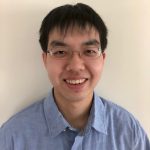 Kenneth Lin
Kenneth LinHome Institution: University of Massachusetts, Amherst
Status: Sophomore, Expected Graduation Date: May 2020
Field of Study: Physics and Astronomy with a Minor in Mathematics
Host Lab in Japan: Kyoto University – Solid State Spectroscopy Group, Tanaka Laboratory
Host Professor: Prof. Koichiro Tanaka and Prof. Takashi Arikawa
Research Project Abstract & Poster: Ultrafast Carrier Dynamics of Exfoliated Transition Metal Dichalcogenides with Optical-Pump Terahertz-Probe Microscopy (PDF)
Why Nakatani RIES?
As an aspiring scientist interested in language and cultures, I applied to the Nakatani RIES Fellowship for its balanced emphasis on intercultural learning with language training and intensive research through student exchange in Japan, a well-established leader in engineering and physics. As a Taiwanese-American, I found Nakatani RIES to be the perfect opportunity to more deeply understand Japan, a nation which has significantly influenced the development of Taiwan technologically and economically, and the role that its culture plays in driving scientific and societal progress. My interests and experience in astrophysics motivated me to apply for Nakatani RIES to expand my research scope into experimental condensed matter physics, a research area critical to developing the tools of astrophysics as the instrumentation and laboratory techniques rely on the multidisciplinary expertise of international teams of scientists and engineers. By deeply exploring the distinct yet interrelated field of solid-state physics, I hope to contribute diverse technical and scientific experience across different areas of physics as part of global research in nanotechnology, which will accelerate scientific advancement in interdisciplinary fields such as astrophysics.
Participating in Nakatani RIES would further my goals by building a foundation in experimental physics that would both complement and enrich my current work in astrophysics which relies on computational analysis. This focused training in experimental applied physics will enable me to broaden my research background to include an experimental emphasis as I work towards graduate school, leading to new opportunities for me to contribute in astrophysics-driven projects including telescope instrumentation research, which increasingly relies on interdisciplinary background in engineering, materials science, and nanoscale physics to develop. Furthermore, Nakatani RIES allows me to be directly immersed in international collaboration through exchanging with my Japanese peers and mutually sharing these experiences, a unique perspective in scientific collaboration that cannot be truly understood by merely observing from a distance. Becoming involved in an international laboratory would enable me to gain cross-cultural competency in a laboratory setting, a crucial skill only acquirable by experience that is necessary to thrive in the ubiquitous global nature of scientific research.
Goals for the Summer
- Grow my research experience in condensed matter physics, especially with instrumentation and experimental techniques
- Gain a deeper understanding of the cultural and interpersonal skills necessary to succeed in increasingly globally-connected scientific research collaborations
- Achieve essential conversational proficiency of Japanese and a broad understanding of professional Japanese in a scientific context
- Establish a lasting relationship with host laboratories, mentors, and Nakatani U.S. and Japanese Fellows
- Ride the Shinkansen and go to a railway museum
Meaning of Nakatani RIES Fellowship (Post-Program)
When I first applied to the Nakatani RIES program, I sought to experience research in Japan and its strengths in nanoscience to gain broader insight into how international collaborations in research shapes the cutting-edge of science. Coming to Japan for the rst time and with fresh eyes, I discovered how Japan has embraced culture and learned from others to advance its society for the betterment of a people. The countless UNESCO World Heritage sites in Kyoto echo the core of the Japanese nation and its history, a fertile ground for a millennium of intellectual inspiration. The meshing of culture, science, and art became clear during my time in Kyoto and I will long consider these months a formative academic and personal experience. Most science and engineering students do not have this opportunity to study abroad, let alone conduct research abroad, and I am deeply grateful to the Nakatani Foundation for providing this chance to stay in Japan for an extended period of time and carry out research in leading Japanese universities. My favorite experience in Japan was meeting and interacting with our counterpart Japanese Fellows. This unique group of peers also interested in international research allowed me to easily form strong relationships which I hope to extend far beyond the program.
Research Lab Overview
While I entered the Solid State Spectroscopy Group with minimal experience in condensed matter physics, the experimental work I carried out significantly inspired my interests in fundamental physics research as I came to realize the power of transferable scientific skills. This discipline of physics exposed me to the realm of optics, lasers, and their immense potential to disrupt current paradigms in materials engineering and scientific instrumentation. In the lab, I investigated the carrier dynamics of atomically-thin, single crystal transition metal dichalcogenides (TMD) using optical-pump terahertz microscopy. My work in this project was the first attempt in the world to image in the near eld a TMD sample within the terahertz regime, an effort defined by the uniqueness of our setup and instrumentation capabilities. The internationalism of the lab further made my time more vibrant as I worked alongside researchers from around the world, including a professor from Canada with whom I collaborated closely with on my project.
Although my work in this lab was related to solid state physics rather than my astrophysics where my research interests lie, I found connections between both fields that allowed me to grow as a researcher. Most notably, I was trained with critical experimental lab skills and tools including imaging analysis, Raman spectroscopy, and atomic force microscopy, techniques that I would not typically be exposed to in astronomical research. I gained a greater understanding of the background necessary to engineer new scientific tools through this training in experimental physics research, skills imperative for the development of astronomical instrumentation. My experience this summer has opened the possibility for me to pursue interdisciplinary work with experimental methods in astronomy through graduate school and career, using a theoretical objectives in astrophysics and experimental techniques of optical physics to inspire new innovation in space telescopes and imaging technologies.
Coming to work in the laboratory everyday was a true joy and privilege that I hope to continue in my career in physics. Not only did I have many students including undergraduate and graduate to consult with, but I most literally worked alongside postdocs and professors in a highly collaborative atmosphere. While the students were under no expectation to work the hours that they did, the hours and dedication that students invested into their research demonstrated that they truly enjoyed their work. Coming from a theoretical lab, I had little experimental experience but my graduate student mentor patiently guided me from material fabrication to analysis, checking in with me every step along the way. Both my host professors and graduate students with whom I received help from took valuable time out of their daily agendas to tutor me through operating instruments and running experiments. The general environment was entirely relaxed and my fellow lab members even remarked to me how “unique” their lab was compared to the typical Japanese lab, commenting how they themselves were likely the “liveliest” group in the physics building. In many respects, I concur with this self-assessment as it would not be unusual for half the lab to break into a conversation at any time. The lab group oftentimes resembled a group of friends who happened to have common research interests, where we would go on group lunches and dinners nearly everyday. I sincerely appreciate the warm group cohesion of my lab as it inspired a healthy work ethic balanced by a genuinely welcoming friendship.
Daily Life in Japan
The practical component of living in Japan was one of the most interesting and rewarding challenges that I have experienced even as I have spent significant time abroad growing up. Much of my life assimilated into a typical Japanese graduate student’s routine, where I spent a minimum of eleven or twelve hours in the lab building. I experienced a typical Japanese commute every morning, traveling by bus from Higashiyama-ku near Kiyomizu-dera to the main university Yoshida campus in Sakyo-ku. After the core morning segment of work, I would have a delicious meal at the North Campus cafeteria, food that I continue to dream of even after returning to the U.S. The workday would close with a group dinner at a local establishment, a practice that allowed me to try over twenty restaurants in the Hyakumanben area. Before returning home, I would always go the supermarket to buy the next day’s breakfast, either bread or onigiri. My love of railway transportation and experience with reading Japanese proved valuable on weekends when I had the opportunity to travel around the area. As a result, during my time in Japan, I have never taken the wrong bus or train and in the market, I have never unintentionally purchased a product as a result of language misunderstanding. Being able to navigate independently and run errands without much issue was a highly rewarding part of living in Japan. I was able to visit railway museums in Kyoto and Nagoya, in addition to eight World Heritage sites in Kyoto Prefecture, Lake Biwa, Nara, and Osaka. Climbing to the summit of Mount Fuji to witness the sunrise at the conclusion of my time in Japan was one of the most interesting experiences I have had that was a fitting way to close my time in the land of the rising sun.
Experiences with Japanese Culture
Living in Japan for the summer enabled me to probe deeper into Japanese culture than a brief stay would have revealed on the surface. Working with Japanese students allowed me to learn much more about their perspectives and as the summer progressed, I began to sense the subtleties of the culture. For instance, I learned much about how Japan views foreigners and tourism, especially relevant in Kyoto where tourists populate the many temples, shrines, and castles embedded in the city. My unique position as a student in the lab and as an international visitor allowed me to share the Japanese perspective of welcoming tourists for economical benefits while preserving the pristine state of important cultural properties. Visiting the many museums and historic centers of Japan, including the Tokyo, Nara, and Kyoto National Museums, and the Takasaki archaeological site enriched and informed my observations and interactions later on. While Japan has had historical periods of closed and open periods of foreign influence including in today’s globalization age, the Japanese people have a strong sense of national identity and have always kept their culture and heritage alive. Outside spheres of influence has only served to improve Japanese society where the most positive aspects of foreign cultures are extracted and adapted into their own lives. Recent history has shown how Japan successfully modeled its Meiji Restoration with the German-Prusso model of governance and incorporated the German culture of precision in which Japan takes pride in today with its high-quality manufacturing and emphasis on punctuality to name a few lasting impacts. This tradition of learning and adapting truly demonstrates how the Japanese society embodies societal progress that is culture-preserving and self-improving. This humanistic characteristic of Japanese culture has personally reinforced my idealistic goal to stay well-grounded in history and philosophy, and having values rather than economics guide my scientific career. Although difficult in the modern world of politics and interests where it is all too easy to become caught up in the technical scientific issues, I hope to keep my eyes trained on the big picture and to always humbly look forward to the future without losing sight of the past.
Before I left Japan, I wish I had… taken more opportunities to travel outside of my host city into the more rural areas in the country. Being in a city with high tourism activity, seeking a less trodden path would be a refreshing contrast.
While I was in Japan, I wish I had …. proactively spoken more Japanese to enhance my oral communication.
Excerpts from Kenneth’s Weekly Reports
- Week 01: Arrival in Japan
- Week 02: Language Learning & Trip to Mt. Fuji Lakes
- Week 03: Noticing Similarities, Noticing Differences
- Week 04: First Week at Research Lab
- Week 05: Cultural Analysis – Life in Japan
- Week 06: Cultural Analysis – In the Lab
- Week 07-08: Overview of Mid-Program Meeting & Research Host Lab Visit
- Week 09: Research in Japan vs. Research in the U.S.
- Week 10: Reflections on Japanese Language Learning
- Week 11: Interview with a Japanese Researcher
- Week 12 – 13: Final Week at Research Lab & Re-Entry Program
- Final Research Overview and Poster Presentation
- Follow-on Project
- Tips for Future Participants
Week 01: Arrival in Japan
The pre-departure orientation predominantly consisted of cultural and adjustment advice from past alumni and the program. Having lived abroad for a couple of years and with significant experience in international travel, the vast majority of this information seemed to cleanly summarize what I have personally already learned. While much of the information presented I have already abundant experience with, the opportunities to network with alumni and students based at Rice was a significant channel for me to meet like-minded students pursuing similar areas of research in physics and learn more about their scientific experiences in Japan. Meeting with the successful alumni of both the Nakatani RIES and NanoJapan program were highlights of orientation that were invaluable for gaining perspective into what opportunities participating in international research can lead to in research through graduate studies.
In some sense, the work ethic of Japan and the United States lie at opposite extremes. While in the U.S., each accomplishment in earned and deserved independently, there is a significantly tangible role of the group in Japan. Nearly every aspect of the Japanese culture can be traced to the collectivist center that dominates much of East Asian values. The values of effort, harmony, understanding, and form result from what seems to be the key core value of maintaining human relations, 人間関係. While this may maintain robust surface-level relations, this working style may potentially stifle creativity and critical thinking, especially on a humanities and sociological level. However, this type of concerted effort as a group towards a common goal also introduces benefits not observable in the U.S. For instance, in a scientific context, lab groups seem tightly-knit and work on fairly similar projects towards the larger goal of completing a research study or designing novel instrumentation. In visiting the labs at the University of Tokyo and speaking with the graduate students and fourth year undergraduates, I observed that within the group there was perceptible harmony that takes form as an “in-group” where members partake in activities beyond work on a regular basis. Maintaining the right relationships also includes observing well-defined hierarchy in Japan. This often means that the professor in the lab may seem more distant from the students whereas in the U.S., the professor of a group often treats their students as research colleagues. While this culture promotes excellent working relationships, it is often unclear what the underlying thoughts of others are and is a potential source of miscommunication. The emphasis on such honorifics and titles in Japan is a unique one where I have always found an interesting challenge. As another example, I was introduced to a researcher with a title of Assistant Professor, however when I addressed him as “~sensei” out of custom, the graduate students corrected me and reassured me that using “~san” for him is acceptable and even expected, a bit unusual but perhaps the case because of close age. This particular emphasis on titles, naming, and addressing are common characteristics that I observe every day that help Japan maintain a society that embodies harmony above almost everything else. While this is quite different from American values, this is certainly not my first time with emphasized “respectful” communication and thus, I adjust myself accordingly to maintain this sense of order and harmony.
Having been brought up in multiple countries, I may not necessarily embody only the American core values, but also have familiarity with how others may think. However, there are instances especially in Japanese class both in my home university and here when my investigative side insists on a more direct answer or a request of my own. While expecting direct responses to requests and questions is the norm in the U.S. where the people are generally more forthcoming and straightforward, even using a more direct tone with the Japanese tends to take them aback. While I have not personally experienced this myself as I have adjusted my speech and intonation to better fit Japanese cultural communication, I will continue to watch for potential areas where such Western values including independence and projected self-confidence can conflict with Japanese custom.
Having only lived and been to countries with right-hand driving, my first impression of Japan was the novelty of driving left-handed. Although I already knew about the traffic system in Japan, traveling along the left side of the highway and even walking on the left side of the sidewalk was a source of initial disorientation. Coming into Tokyo, I also noticed that the streets and sidewalks were impeccably clean—there was not a single trace of litter anywhere to be seen on the streets. While the layout of Tokyo with its many wandering alleyways were analogous to the city of Taipei in Taiwan, the key difference was the striking cleanliness of Tokyo. Although one of the largest metropolitan areas in the world, the cultural discipline has allowed to the city to remain in nearly spotless condition. Despite knowing that Japan has a cultural tendency towards impeccable cleanliness, I was certainly surprised and impressed that Tokyo is able to maintain this level of sanitation with the number of tourists that traverse its streets every day.
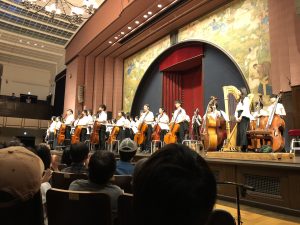
What may be most challenging in Tokyo is the lack of a strong public access Internet network across the city that has made it difficult to communicate with my lab groups in Japan and back home. Although I was informed of the lack of ubiquitous access to Internet in Japan by several Japanese students at UMass, I did not realize the extent of this until arriving in Tokyo. In nearly all major metropolitan areas around the world, public Internet access especially for foreigners have become a staple of the tourism industry. As a technologically savvy city, the lack of a public network system becomes more than a slight irony especially when cities including Boston, Toronto, and Taipei all feature abundant Wifi access points throughout the metropolis.
As a byproduct of small class sizes, Japanese language class is less structured and more personalized than what can be expected at a public or private university. However, much of the material to be covered I had already completed in Japanese class at UMass, which allowed me to use this opportunity to solidify my grammar and address any questions directly with an experienced Japanese instructor. I am using Japanese on a daily basis almost by default because I am always being addressed in Japanese. Instead of using English in return, I try my best to complete the exchange in Japanese, particularly in simple situations such as in convenience stores, shops, and restaurants.
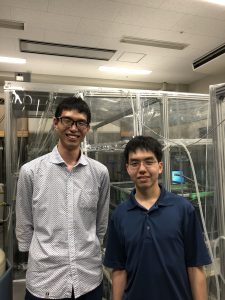
The University of Tokyo laboratory visits were an important highlight of my first week in Japan. Not only was I able to visit the Tabata Lab for bioengineering and tour the UTokyo user facilities, but I was invited to visit the Shimano Lab for physics to extend my network by using my existing network. This experience was particularly valuable because the research area the Shimano Lab pursues is closely aligned with the research topics I will be studying at the Tanaka Lab in Kyoto. Since I have minimal experience in experimental physics and especially in solid state physics, being introduced to the research methods and instrumentation involved in this research area will be invaluable to my preparation for research at the Tanaka Lab. I was even able to meet one-on-one with Shimano-sensei in a meeting that lasted about an hour where he introduced me to his research interests, current developments in the field including the Higgs mode in low temperature superconductors, and their current work on seeking analogous behavior in higher temperature superconductors.
Additionally, I also found the Taiko drumming a particularly valuable experience to understand historical Japanese culture through a musical lens. As a musician myself, I found Taiko drumming to be especially relevant to musical evolution in Japan when the U.S. was not even discovered yet. The drumming was an outstanding hands-on experience that helped recreate the mindset perspective of traditional Japanese warlords when the country was not yet internally stable. The sumo wrestler talk was similarly a valuable introduction to a key surviving part of Japanese culture that provides us with a background prior to witnessing sumo wrestling ourselves. The Ikebukuro Life Safety Training Center visit was also an invaluable experience which introduced practical advice in the event of a natural or manmade emergency. I especially found the earthquake simulator to be significant as experiencing such a disastrous phenomenon allowed us to truly understand the magnitude of severity earthquakes can cost.
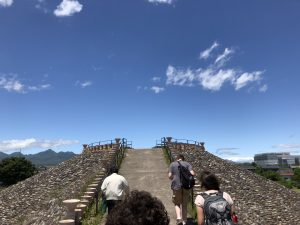
Finally, the Takasaki archaeological tour was another highlight of the week which provided an in-depth introduction to the ancient history of Japan, its elites, and their traditions. It was powerful to witness thousands of years of history that has culminated in modern-day Japan from keyhole-shaped burial mounds to square mounds. With the academic commentary from Professor Ken’ichi Sasaki of Meiji University, the visit was a comprehensive learning experience for me about the Japanese elites, government, and farmers. The political power wielded by landowner elites in Japan reflects a societal power structure that reminded me of pre-colonial Taiwan. From ancient history, Japan has always seemed like a stratified society and continues to reflect that today. Keeping this legacy in mind allows me to place cultural and historical context with current Japanese core values, such as a strict respect for elders, teamwork for a greater goal beyond the individual, and a united front.
Research Project Overview
This summer in the Tanaka Lab at Kyoto University, I will learn how to create monolayer samples of transition metal dichalcogenides (TMD), for instance with molybdenum sulfide, and measure its transmittance in the terahertz regime using the terahertz spectroscopy. While current research has investigated the THz transmittance of TMDs, the THz transmittance of single crystals has not been measured yet. By They also have unique optical and transport properties with the valley index, a new degree of freedom for charge carriers. This property opens a new category of ways to store and manipulate data called valleytronics. When electron energy is plotted relative to momentum, two deep valleys result and since ultrathin materials are sensitive to light, the valley can be controlled by incident light; consequently, if perturbed the two valleys can have unequal depths and allow electrons to have a preference for one of the two valleys. Monolayer TMDs are semiconductors with finite bandgap and are distinct from graphene which are semimetals which have no bandgap. While graphene has a high carrier mobility, the zero bandgap and thus cannot be “switched off” which effectively disqualifies graphene as a transistor. Two-dimensional TMDs however have emerged as a promising class of materials as they display a band gap with semiconducting properties similar to that of silicon, enabling the possibility of atomically thin transistors. Thus, ultrathin layers of TMDs have potential to serve as circuit components in fast electronics.
Week 02: Language Learning and Trip to Mt. Fuji Lakes
Week 02 Overview
The visit to JAMSTEC in Yokohama considerably broadened my insight into the Japanese scientific computing industry and in particular, its immediate societal applications with the Earth Simulator. As a highly seismically active zone, Japan combines its prowess in advanced electronics and expertise in geological studies to deep-sea drilling and creating earthquake monitoring areas that provide a warning system to the government should an earthquake source be detected. The ability of the marine vessels to drill deep through the Earth’s crust towards the mantle is itself a feat of engineering motivated by the potential to minimize the devastating effects of earthquakes as much as possible. Although the physical location of the supercomputing clusters was not accessible during this visit, viewing the cooling systems of the supercomputer facility allowed me to appreciate the vast magnitude of the JAMSTEC effort to push scientific and engineering limits for the benefit of those most vulnerable in the wake of natural disaster events. I have always been motivated by “science for the benefit of mankind” and the sophisticated and important mission that JAMSTEC undertakes was an inspiring time to reflect on the larger picture of how understanding fundamental physics has the potential to be of service to society.
The Edo-Tokyo Museum was one of my highlights of the week, dense with historical artifact and stories of how Japan developed socially and technologically. The numerous models, replicas, and exhibits demonstrated the extraordinarily rich history of Japan through the transformative Edo period and how Japan developed in the Meiji restoration. The immense volume of content and detail of the models and recreations enhanced my insight in how Tokyo developed to its current status as a global city. An important and overarching theme that reverberated through Tokyo’s history is its culture of education and learning, where literacy across all strata of society was nearly complete. Moreover, literature, schooling, and reading were heavily emphasized even prior to the entry of the Western spheres of influence. This systematic and disciplined way of life is evidenced today in the manifestation of modern Japan’s leading role in scientific and literary scholarship and is a testament to the vital role that a people’s culture plays in shaping its national standing. The Grand Sumo Tournament was a unique first experience of an ancient Japanese tradition that was a fitting segue from the history presented at the Edo-Tokyo Museum. I was impressed by the very stadium in which the competition was held as it seemed the arena was designed solely for sumo tournaments. This demonstrates the value that Japan places on the sport of sumo wrestling, particularly as a source of national cultural pride as the tradition makes a revival in today’s Japan. The orderly, procedural process in which each segment of competition was carried out demonstrated the importance that Japan places on its history and tradition. As a result, despite seeing a brief decline in popularity of sumo wrestling due to cultural shifts, sumo is experiencing a resurgence once again as Japan seeks to preserve and cherish its traditions. The amount of time spent watching the sumo wrestlers prepare for their turn in the competition ring far exceeded the total actual competition time and after the winner of each round was determined when either contestant was pushed to the ground or outside of the ring boundaries, it was very clear when the competition ended. Despite the substantial monetary stakes of this major tournament, the sumo competitors demonstrated deep respect for one another and reverence for the sport of sumo itself as exhibited by fair play and bows at the end of each round. It was at the sumo competition in which I truly witnessed the respect that the Japanese people place on their national heritage and culture.
The intertwined history of Japan and the United States as presented by Professor Sayuri Shimizu-Guthrie in the context of baseball, a vastly popular sport in both countries, was a unique perspective that I appreciated coming from a diverse background. Although the United States and Japan have undergone vast societal transitions domestically and internationally, the two nations mutually developed through common bonds such as sports. The United States for instance played a significant role in contributing to the Japanese system of education through educators who came to Japan and Japanese students studying in the United States. Prof. William S. Clark, the third president of Massachusetts Agricultural College, now UMass Amherst, established Hokkaido University in Japan. The considerable overlap between the two nations with respect to sport and their roots in education development demonstrates how increasing globalization in history has led to otherwise unusual shared pastimes. Although the rules of baseball are identical, I also learned that Japan has developed its own style of baseball in which the game is taken quite seriously compared to the U.S. where being an audience member of a game is a fairly laid-back and carefree experience. Even when new culture is introduced in Japan, there is always some amount of localization that occurs which allows Japan to codify its unique style and continue a long tradition of culture preservation.
Language Learning Experience
Japanese language class has mostly been a review of what I have already learned in my Japanese language classes back home. This continues to help me supplement my familiarity and proficiency with more advanced grammatical structures that are directly applicable in everyday lexicon. The Japanese language conversation proficiency evaluation that lasted a duration of more than forty minutes was one of the most substantial learning experience during these classes. Holding a content-driven conversation with a native Japanese speaker allowed me to practice increasing my rate of speech production, fluency, and accuracy. I was pleasantly surprised at what stilted Japanese I was able to conjure during this conversation, but when I was asked to describe my research in Japanese, I was only able to “katakanize” the technical English terms, which I am sure was more than halfway incomprehensible. Because I know this will not be the only instance where I may be asked to describe scientific terms in Japanese, I have made it a goal to learn how to give a synopsis of my research topic in Japanese. I hope to accomplish this during my time in the laboratory by attending journal clubs and using the language as much as I am able in the laboratory setting. However, I enjoyed my experience here especially as a Japanese language learner, it is often challenging to seek situations where I would be able to use the language in a more substantive context than the typical phrases used in daily life. Because survival language is used so frequently, I have not had too many difficulties in communication in daily life, since interactions with store clerks and staff are typically set phrases. I have felt surprisingly prepared for these interactions and has been one of the most interesting experiences in Japan. Learning a language in an area where the language is rarely even heard and applying my training in the global classroom of Japan is and likely will long remain a surreal and rewarding experience.
Mount Fuji Lakes Trip

We met the 2018 Japanese Fellows early in the morning as we began our trip to the base of Mount Fuji. While initially the two groups self-separated, we soon learned that the Japanese Fellows were actively interested in what life was like in the United States and this was the starting point for engaging in interesting conversations which began from university coursework and flowed into student life in Japan compared to the United States. After the first segment of travel, we arrived at the Oshino Hakkai Springs, a UNESCO World Heritage site with eight distinct spring ponds each with a symbolic enshrined deity. These ponds formed from the eruption activities of Mt. Fuji where crustal deformation caused the lakes in that were originally around the mountain to dry and become basins for spring water that continue to be replenished from the underground water stored within Mt. Fuji. The picturesque location and historical significance of these springs elicited conversations with the Japanese Fellows about the natural environment in the United States and what they could expect in Texas. Shortly thereafter, we toured the Kitaguchi Hongu Fuji Sengen, an ancient shrine dedicated in part to Mt. Fuji which was perceived as a form of deity itself. Once again, the respect that the people embody for Mt. Fuji is apparent through their traditional religion. These visits to shrines prompted conversations about religion in Japan and the United States over lunch. In one particular exchange, I learned that most of Japan was indifferent to religion which seems rather unusual given the high value Japan places on culture in which religion customarily shapes much as how Christianity shaped the early history of the United States with the initial settlement of the Puritans in New England. I was also told that the Japanese observe Christmas Day as a holiday where families are able to return home and reunite, which made for thought-provoking dialogue on how religion is viewed in both countries.
Afterwards, we proceeded to the Fifth Station of Mt. Fuji, the highest point reachable by vehicles. The temperatures even at the Fifth Station were more than ten degrees centigrade lower than that at the base of the mountain. Although conditions were overcast, it was clear why snow remains year-round near the summit. It was quite striking to appreciate the sheer height of Mt. Fuji, the icon of Japan, as we neared the Fifth Station and ascended the winding slopes of the road. After stopping briefly for photos and a visit to the souvenir shop, we headed to our hotel at the Gotemba Kogen Resort. While typically, a hotel may not deserve an extensive narrative, this particular establishment is worth expanding upon. We were welcomed by a large sign with wooden lettering “Blueberry Lodge, Welcome Friends!” After obtaining our room information, we entered the hotel only to realize that each “room” was a discrete hut in the shape of a circle, the setting of which resembled scenes from Peter Rabbit and Alice in the Wonderland. Beyond the complex of circular huts, there was an amusement park-like scene with a carnival-style carousel, an oversized bell, and cartoon character features from American film. After an abundant buffet meal that night, we explored the resort complex with the Japanese Fellows and watched an impressive water fountain light show located in this “carnival.” The eccentricity of this hotel was a moment for the U.S. and Japanese Fellows to bond in wonder of our accommodations. Later that night, I experienced the therapeutic benefits of Japanese onsen for the first time with the Japanese Fellows, of which further built our rapport with each other.
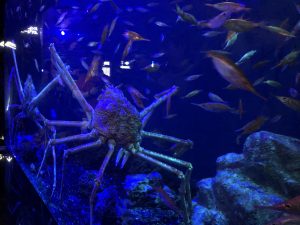
The next morning, our first stop was at the Numazu Deep Sea Aquarium where we were able to view the endemic marine species of Japan’s shores and sea. The Japanese spider crab, Macrocheira kaempferi, has the largest leg span of arthropods and was a major feature of the aquarium’s collection. I also found the various exotic deep-sea marine wildlife to be especially intriguing because of the sheer diversity of life that remains hidden in the depths of the Pacific Ocean alone. We had a seafood lunch adjacent to the aquarium where fresh fish, scallops, shrimp, and shellfish were cooked on grills built into the dining tables. Being next to a major fishing port, the seafood was extraordinarily fresh and only replicable at cities located by the coast.
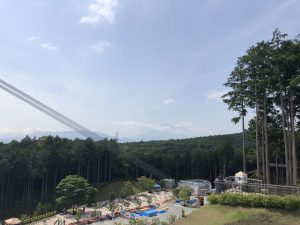
The Mishima Skywalk offered a stunning panoramic view of the mountain ranges surrounding Mt. Fuji across the longest suspended bridge in Japan. Although slightly windy, the 400-meter bridge swayed harmonically in the air, serving as a live example of simple harmonic oscillation on a well-constructed bridge. Along the skywalk, the outlines of Mt. Fuji were visible in the distance as the distinct volcanic mountain that stands apart from the tree-covered companion ranges. After taking in the spectacular sights at the skywalk, we proceeded next to a local strawberry greenhouse where we had all-you-can-pick and eat strawberries. While some engaged in strawberry-eating competition, I sought to carefully compare the taste of strawberries in Japan to those grown in the United States. As I came to realize, the strawberries in Japan have a distinct sweetness that is reflected in Japanese strawberry-flavored beverages and desserts that I have always thought to be different from strawberry-flavored foods in the United States. In the U.S., it seems as though strawberries have slightly stronger acidic presence that enables the fruit to be carry a so-called “tangy” flavor, whereas in Japan the strawberries are smaller in size but have an increased density in the natural sweetness of strawberries. Only personal experience can fully bring appreciation to this distinction.
I had engaging conversations with nearly every one of the Japanese Fellows. In many senses, the approach to conversation with the Japanese college students mirrors my interaction with Taiwanese college students. Thus, I became comfortable with the Japanese Fellows fairly quickly and established warm rapport. In conversing with the Japanese students, I learned a few engineering students have similar interests to my own in aerospace and space systems, being involved in rocket-building clubs and fabricating propulsion designs, and I was able to share my interest in astrophysics with the future engineers who will build the next generation launch and delivery vehicles. On a social level, staying with the Japanese Fellows as roommates and participating in the onsen was one of the fastest ways to form bonds with our Japanese counterparts. I noticed that the Japanese Fellows were very patient and willing to speak proactively, which if based on the Japanese cultural values introduction we were given, would not be an expectation. However, I learned that many of the Japanese Fellows have had international experience and have outstanding command of the English language and thus have adopted an American-style demeanor when interacting with us. Their ability to adapt quickly to diverse situations and accommodate our lack of proficiency in Japanese was clear demonstration of the value they place on forming harmonious relationships.
Since half of the U.S. Fellows will be in the Kyoto and Osaka areas during the research period, the Japanese Fellows who are from Kyoto or are students at Kyoto University offered to remain in contact, a warm gesture that has made me feel welcome even before I arrive in Kyoto.
Question of the Week
Christmas is a Christian observance which must have rose from Western influence but has Christmas in Japan always been a commercial marketing holiday? As a generally non-Christian country, does Japan understand the history of Christmas and why it is observed? To extract and overlook the religious tradition behind a religious holiday seems to render the observance of Christmas to be merely a business-driven holiday meant to boost sales.
- Just like many aspects of western or foreign culture, Japan has a unique way of taking in various traditions and making them uniquely their own. For example, did you know that on Valentine’s Day in Japan women give chocolates to men? Only to receive chocolates from men back on White Day. And, the ‘traditional’ Christmas dinner in Japan is KFC? Also, the Tanabata Festival in Japan is actually taken from a Chinese QiXi or Double Seventh Festival? That being said, yes, Christmas is primarily a commercial holiday in Japan. However, the same could also be said of how Christmas is celebrated by many people in the U.S. and Europe today too… in spite of its religious roots.
- For more on this see:
- Festivals and Holidays in Japan
- Religion in Japan – Particularly the section on Christianity and Other Religions in Japan
- Christianity is one of the primary religions in Japan and there are churches where you can attend services year round. A number of past U.S. students have regularly attended church services in Japan as a way to reconnect with their spirituality and broaden their community/network in Japan. During the research internship period, you may want to seek out a church to attend to meet fellow Christians in Japan and talk with them more about the meaning of religion in their day to day life.
Intro to Science Seminar
The technical overviews of the scientific talks were most helpful and relevant to me personally because it enabled me to place the theoretical physics acquired from the classroom in the context of research and nature. Because much of the material related to solid state physics is somewhat foreign to me, having never formally nor informally studied the field myself as I am coming in from an astrophysics-focused background, being shown how the fundamental quantum physics principles are identical in the context of solid state and materials physics was reassuring. The applications of understanding physics here was also very helpful in motivating the research a framing a context for this work. For instance, both Professor Otsuji and Professor Saito of Tohoku University mentioned the relevance of solid state physics research across interdisciplinary fields including astronomy. In particular, I appreciated the connection that Professor Saito made to the Atacama Large Millimeter/submillimeter Array (ALMA) interferometer in Chile, where the data analysis of each survey release is led by multiple research groups at UMass. The seminar by Prof. Otsuji primarily discussed the current research areas in graphene and terahertz sciences and was complemented by Prof. Saito’s discussion on carbon nanotubes. Prof. Saito also brought in mini-demonstrations with a slice of carbon with high thermal conductivity which cuts through ice surprisingly easily. These explicit demonstrations and graphic presented by the theory and realized by experiment was an important outlet for me to connect the theoretical and technical review of quantum physics from Prof. Kono to the frontier research areas carried out by Prof. Otsuji and Prof. Saito. With the introductions to terahertz technology, by experimentally studying and using terahertz spectroscopy in the context of solid state physics, I hope to be better prepared to contribute to the development of terahertz technology in astronomical applications.
I will be studying monolayer MoS2 and possibly related monolayer TMD materials yet to be determined. Such transition metal dichalcogenides exhibit semiconducting behavior much like silicon. The dimensionality of the material is 2D since it is one atomic layer thick. I will be primarily studying the optical and thermal properties of the material through terahertz spectroscopy. With special optical properties with respect to transparency, absorption, and refractive indices, in addition to high flexibility and high fracture strength, MoS2 is promising for applications with electromechanical sensors. TMD monolayers have applications in optoelectronics arising from their direct bandgap which is not present in graphene and in valleytronics, a promising direction for quantum electronics. While my mentor has mentioned that I will be learning how to make monolayer samples, and although I know the main methods of fabricating 2D TMDs are from CVD, MBE, and exfoliation, I am not sure what processes I will be handling in particular as I am awaiting to hear from my lab.
Week 03: Noticing Similarities, Noticing Differences
While Japan’s public transportation system may offer quite a different experience from a typical American public transport scheme, it is not uniquely distinct from the different public transportation systems that I have experienced. I will discuss the subway and rail network since that is the primary means of public transportation in the Tokyo metropolitan area. The most significant contrast from the subway and bus systems in the United States is much like the city of Tokyo itself, it is extraordinarily clean and orderly despite the vast number of commuters using the system during peak hours. The closest comparison I was able to make with the Tokyo Metro system is the Taipei MRT network. For instance, both systems discourage or limit food consumption onboard the train and commuters alighting the train are given the right of way during station stops prior to the boarding of passengers. When passengers stand, they are also facing the seated passengers out of respect on both sides of the aisle. People are courteous and yield their seats to those in need especially in the priority seating zones. However, during the rush hour such an immense volume of commuters use the subways that standing space becomes a commodity. Although the Japanese people typically keep to themselves and prefer minimal physical contact, the rush hour is a major exception where insistent and strategic pushing is necessary to get in and off the train at the right station. During the rush hour, riders carrying backpacks and bags are expected to either carry it front-facing or carry it rather in an effort to conserve physical space. However, during non-peak hours, it is acceptable to keep backpacks on backs; one consistent rule is to never place belongings on seating areas, since seats are almost always filled at all operating times.
The activities that commuters engage in on the run seem to be universal perhaps due to the ubiquity of electronic devices in the globalized information age. The vast majority from middle to advanced age riders are using their smartphones for various purposes. Occasionally there are those who choose to take a brief shuteye and passengers such as myself who venture to the very front or back of the train to admire the views of the tracks. There is minimal oral conversation onboard trains during non-rush hours although the rush hour certainly experiences a rise in volume. However, passengers do not eat or drink onboard the train; even if there are vending machines on the platforms, food is not consumed once inside the train. This habit is reminiscent of what is absent outside—Japanese people do not both walk and eat simultaneously.
The frequency of subway train operation is much greater in Tokyo than in Boston. On nearly every line during the daytime, the waiting time at the platform will be under one minute. As foreshadowed from the Japanese expectation for punctuality, the arrival times of the subways are impressively precise to the second to maintain the frequency of the trains. As a result of the expected precision timing of the public transportation, commuters need not be concerned about running late if time is properly budgeted. While everyone does walk with a purpose, I have not seen individuals frenetically navigating the subway system; most seated passengers do not even move towards the entryways of the train to exit before the vehicle is completely stopped. The order and discipline found even in seemingly chaotic situations is a unique aspect of Japanese culture that is visible from the public transportation system.
The Japanese rolling stock used for the subways and JR commuter lines are also remarkably well-maintained and updated whereas in the U.S., the infrastructure is generally dated and visibly in need of maintenance. On the Hibiya Line for instance, many of the rolling stock used were newly acquired from the Osaka-based company Kinki Sharyo, which is the manufacturer of the rolling stock used in the Boston MBTA Green Line and the Dallas Area Rapid Transit (DART). Other common manufacturers include Hitachi and Kawasaki Heavy Industries. These subway cars are densely equipped with clear signage in at least three languages—Japanese, English, and Korean. In many cases, there is also Mandarin Chinese signage. The multilingual inclusion of public areas in Japan renders Tokyo one of the most tourist-friendly cities and is a sharp contrast to the transport system in Boston which is notoriously visitor unfriendly. The announcements are clearly enunciated in Japanese and English whereas with the MBTA commuter rail, announcements may not be made at all during rush hour. The robustness of the public transport infrastructure in such a dense city reflects the precision and discipline prevalent in Japanese culture.
These contrasts seem to reflect a balance of cultural and practical motivations. Many aspects of Japanese culture are driven by practical needs. For instance, maintaining cleanliness and refraining from food consumption onboard trains is a practical benefit that allows the metro system to remain spotless. Etiquette with regard to train boarding, yielding seats to those in need, and conserving space by carrying belongings are universal gestures that come from practical need. The level of quietness on trains in general however seems to be a product of the Japanese culture to be respectful. In consideration of other passengers especially during non-rush hours, the level of conversation is kept to a minimum. This type of considerate respectfulness is not necessarily abided by in other countries and may be attributed to the Japanese tendency to be quieter and more sensitive.
Orientation Program Overview: Week Three
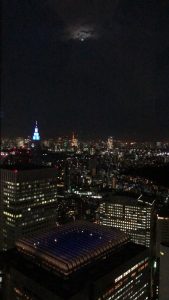
To obtain a skyline view free of charge in Tokyo, head to the Tokyo Municipal Government building in Shinjuku. Rather than ascend Tokyo Tower or Skytree with masses of tourists, the government tower provides panoramic views of the Tokyo cityscape at 202 meters and this was where I headed on Monday afternoon. I entered towards the evening when the sun was slowly setting and set up a spot to take a time-lapse of the city transitioning to night. On the viewing floor, Tokyo Tower could be clearly seen in one direction and the Skytree in the distance in another direction. At nightfall, commercial airliners landing and departing from Tokyo Haneda International Airport could be seen in the distance with their bright beacons and landing lights. I waited about 90 minutes for the skies to reach the darkness of night and read some papers while the time-lapse was running. Although the process was gradual, the resulting footage was well worth the time investment. Building and tower lights slowly came on, the red taillights of vehicles on expressways became deeper in hue, and Tokyo Tower illuminated in a gradient of orange and yellow. To take in these views and how the city transitions to nightlife was a once in a lifetime experience that was somewhat surreal. On a clear day, Mt. Fuji can be seen from the observation deck and makes for an artistic juxtaposition of the world’s most sprawling metropolis with the sacred nature of the mountain ranges in the distance.
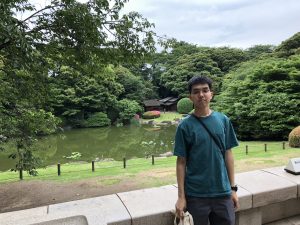
The cultural talks of this week presented valuable background into how the Japanese society behaves interpersonally and what the Japanese value in decision-making. The historical and philosophical perspective in the life sciences presented by Professor Emeritus Shinichi Nishikawa of Kyoto University combined the approaches of a humanistic narrative with a scientific lens. In particular, Prof. Nishikawa extensively discussed the significance of the information age and what potential is hidden in a time where information is readily accessible to a global audience. Although Prof. Nishikawa included substantial content on the evolution of science through philosophy, I cannot agree with his assessment that science is the sole means to define truth. While science may describe the mechanics of natural phenomenon, there is a finite limit in which scientific approaches are relevant. Science is not only driven by philosophy, but at scientific limits, philosophy takes over. Much like Moore’s Law, the more we learn about the science, the more directions we find and at times, we stumble upon very real and physical limits, most notably that of the speed of light and the arrow of time. The scientific method may yield some fundamental truths about the physical world but science especially in today’s domain of modern physics has reached crossroads where the truth cannot be appropriately constrained. The concept of truth is defined by its characteristic of being invariant, and as science is merely a methodology that facilitates the evolution of the human capability to describe nature, science cannot logically be the definer of truth. Nevertheless, Prof. Nishikawa posed several interesting and currently unanswerable questions of how information emerged spontaneously, how language came to be on Earth, and the next steps of neural networks.
The subsequent speaker, Mr. Kento Ito of INNE Japan Corporation, provided valuable insight into the history-rooted culture of modern Japan’s rich culture. He presented extensively on the cultural tradition behind kimono and Japanese tea ceremonies. Some particular methods of kimono-making for instance may take up to two years to complete and these products can become very expensive. Kimono can be crafted from a variety of ecologically-friendly materials as well, including banana tree leaves and wood. The lifetime of a kimono can also last more than one hundred years and reflects the emotional attachment that the Japanese place in a kimono that is passed across generations. After kimonos are worn out, they are repurposed as blankets, and after outlasting that use, are reused as cleaning cloth. Finally, the cloth of the kimono is burned, and the ash spread to catalyze the growth of hemp, the primary material of the cloth in kimono. Japanese tea ceremonies are also extraordinarily detail-oriented and rule-driven. Each step in preparing and serving tea is taken with concentration and precision for the sake of hospitality to the guests being hosted. For instance, when boiling water, one can only think about boiling water and when pouring the tea into the cup, the actual pouring is the only thought in the host’s mind during the process. These aspects reflect the spirit of Japan: valuing tradition, maintaining a disciplined lifestyle, and being precise.
Friday evening, Ozaki-sensei provided last-minute advice on Japanese behavior etiquette when interacting with hosts in homes and appropriate phrases for giving omiyage. There were some interesting cultural facts regarding price bargaining in the Osaka area and what phrase to use when attempting to negotiate for better prices. Being comfortable using honorifics for a diverse array of situations and using the appropriate word forms is an important part of integrating into Japanese society and Ozaki-sensei helped bridge that gap with this final presentation.
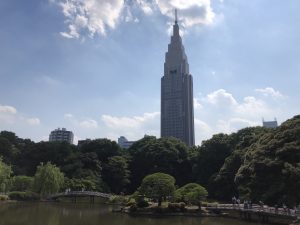
On my final Saturday in Tokyo before the research period, I finally had the opportunity to head to the classic and beautiful gardens of Shinjuku Gyoen. These gardens were formerly under the management of the Imperial Household Agency and now is a national park. The well-manicured lawns coupled with classic span bridges and an abundance of various flora was an interesting contrast to the background of modern buildings and twenty-first century technology. The gardens also featured the Shinjuku Gyoen Goryō-tei, known as the “Taiwan Pavilion” which was presented by voluntary Japanese in Taiwan in commemoration of the imperial wedding ceremony of the Crown Prince in the early Shōwa era who later became Emperor Shōwa. Japanese influence in Taiwanese history is also a major reason why the two nations share many similarities that I refer to in close comparisons. The greenhouse in the garden showcased the botanical diversity of Japan and even included novelties such as cacti and unique orchids. The pristine nature of the gardens in the center of an energetic downtown core reflects the insistence to preserve history and culture in the midst of economic modernization and commercialization.
The language program with AJALT concluded this week with speeches from every student on a free topic, in which I discussed byproducts of Japanese technologies such as the Shinkansen and the notable timeliness of international flights by Japanese carriers. Throughout language class, I have grown increasingly comfortable with employing oral Japanese for basic communication without rehearsing set phrases beforehand. While I have a sufficient vocabulary base to pass by everyday life situations, it was challenging to search in my mental dictionary and produce a comprehensible phrase. The language classes trained me to become more comfortable in speaking Japanese in unstructured circumstances and thus, I was able to confidently present my speech. However, expressing more complex ideas is a formidable challenge for me as I do not have adequate preparation to synthesize the various grammatical structures that I have learned and use them in appropriate ways. A challenge that I anticipate will arise is conversing informally in Japanese; I have only begun to learn about the Japanese informal forms and being able to aurally understand this abbreviated form will be the next hurdle to pass in my learning of Japanese. I hope to also further my vocabulary of kanji so that I approximate meanings based on radicals and context and read at a faster pace especially on public transportation. In expanding my kanji vocabulary, I hope to be able to express a general idea of my research in Japanese during my time at the lab.
Question of the Week
Why is some variety of potato salad included in nearly all types of bentos and set meals?
Introduction to Science Seminars
Prof. Stanton of the University of Florida provided a secondary introduction to semiconductors, carbon nanotubes, and terahertz spectroscopy. In addition, he introduced the background of pump-probe spectroscopy and femtosecond laser pulses. A macroscopic analogy that put the nanoscale world into perspective was imagining these experimental methodologies as stop-action photography, when Leland Stanford won a bet that all four legs of a horse are simultaneously in the air when galloping by capturing the motion of the horse over small time steps. Prof. Stanton also detailed some important and relevant applications of terahertz spectrum technologies to future electronics. For instance, terahertz radiation can be used in medical devices for imaging because the radiation is non-ionizing, unlike x-rays which are ionizing and may over accumulation result in adverse health effects.
The introduction to carbon nanotube synthesis technology from Dr. Don Futaba of the National Institute of Advanced Industrial Science & Technology gave insight into the scientific pipeline and how fundamental research is linked to the industry through government-funded institutes such as this organization. The various methods of crafting carbon nanotubes were a completely new topic to me and I was surprised that there was still a less than precise understanding of how carbon nanotubes are fabricated. While the various methodologies of making carbon nanotubes may be well-known, exactly why a process succeeds was described as a “black box.” While it seems that scientific publications and the subjects of research become increasingly complex and sophisticated, it is pleasantly surprising to learn that oftentimes, many processes in intermediate steps or within the scope of a project is poorly understood. The work that Dr. Futaba leads in AIST addresses these issues by connecting the scientific laboratory to the scaling of novel material production. I also found Dr. Futaba’s personal anecdotes and background as a Japanese-American working in Japan to be relatable, as being educated in the United States and working in Japan is an experience that we Nakatani Fellows are gaining a short perspective of this summer.
The next presenter, Dr. Kunie Ishioka of NIMS, provided articulate insight into the status of women in science in Japan and her research in the ultrafast optical response of metals and semiconductors with pump-probe spectroscopy. It was concerning to learn that women in science, especially in physics, and most especially in Japan, still has a long way to go for equality and opportunity. The Japanese government has undertaken a few initiatives related to encouraging girls to explore STEM professions but as Dr. Ishioka remarked, the kawaii-styled posters may not be the best approach for addressing this disparity. Dr. Ishioka also noted that her birth year experienced an anomaly of a low number of children which she attributed to the long-held belief that during certain years of the zodiacal calendar that it would be more difficult for females to find spouses. Once again, the statistical correlation with these traditions demonstrate how the Japanese do indeed hold to these historic customs.
Return to Top
Week 04: First Week at Research Lab
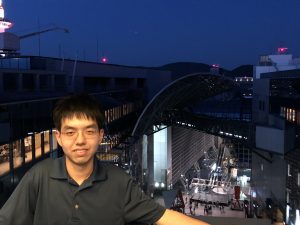
On Sunday, we took the Nozomi Shinkansen superexpress to Kyoto Station to begin our work at the lab this week. Because my apartment lease does not begin until Monday, I spent the evening of arrival at the Kyoto Traveler’s Inn, where we will stay for the Mid-Program Meeting. Since no one from the lab planned to meet Janmesh and I at the station, we spent about fifteen minutes deciphering the Kyoto City Bus system and searching for the right bus to take to get to the hotel. The bus terminal at Kyoto Station is organized into different platforms; it may be worth considering studying the bus system beforehand to expedite the bus boarding process especially as the area in front of Kyoto Station is usually very busy.
The next morning, Janmesh and I set out with all of our belongings that we had in Japan and hauled it onto a bus to check into our apartment. Handling large pieces of luggage, let alone multiple pieces of them, was a true challenge on the bus, especially since most commuters, tourists, and students use the bus. When we arrived at the apartment, we waited for the agent to arrive for check-in. For the first and likely last time in Japan, the agent was quite late to our appointment time that I had to make a call to see if they were on their way. The rare and unusual lack of punctuality on this day affected my schedule for my meeting with Arikawa-sensei, for which I apologized profusely. With no time between finalizing our rental contract and heading to the lab, I was unable to present omiyage on my first day. However, when I brought my group gifts in the next day, they were gone so quickly I never had a chance to see it go. Omiyage-giving can be a delicate task in Japan, but it may be a good strategy to bring edible group omiyage first and then to individuals afterwards especially if pressed for time.
I began to work on my first day in the lab. I first participated in the weekly laboratory meeting with Prof. Tanaka and the entire lab group where I presented a self-introduction in English. Most of the lab members are able to communicate in English but since I am the only native English speaker currently in the lab, the lab members make an effort to use English around me, even to each other. My labmates seem eager to use English but that may also be because I respond in Japanese when possible if they ask a question in English to me. This two-sided effort seems to be a fitting process for the Japanese students and I to have exchange language learning. However, their command of conversational English is at a much higher proficiency level than my ability to handle Japanese. Nevertheless, I strive to continue my Japanese in at least the listening component. After the group meeting, a couple of the graduate students took me out to lunch at the Kyoto University shokudo, or cafeteria. The food in the cafeteria was some of the best food I have had in a dining hall anywhere. Even with UMass Dining ranked #1 in the U.S., I think Kyoto University has already bested that record. Because Arikawa-sensei had to teach a lab section for the rest of the day, I spent the afternoon with different lab members viewing and touring the facilities of the lab, which included four major lab spaces each with distinct purposes and instrumentation. Three of them were laser facilities, with pump-probe systems, a double optical parametric amplification femtosecond laser system, THz and Raman microscopes, and a host of sophisticated laser and cryostat equipment.
However, I was most intrigued by the materials fabrication lab, which they coined the ‘chemistry’ lab because it was where the materials being studied were made. There was an optical microscope that was worth the cost of several cars summed and an argon chamber for reactive chemicals. Since part of my project involves fabricating monolayer MoS2, I am looking forward to being in the chemistry lab. Afterwards, one of the lab members Takiguchi-san showed me his experiment with topological insulators in the terahertz regime, which are applicable in electronics used for secure communications. His description of every experimental procedure and part was clear and precise, and he kindly fielded all the likely trivial questions I had coming into solid state physics with little background. As he ran the experiment, I was pleasantly surprised to notice that the lab primarily uses the Igor Pro software for data analysis. I have used Igor Pro extensively in my lab classes and am comfortable with navigating its many powerful features. Having at least some experience with the analysis software used by the lab was particularly reassuring to me in an experimental lab as foreign to me as Japan.
That evening, the graduate students invited me for dinner in a nearby restaurant where we discussed what food we liked and what countries we have been to. My deskmate Tomoaki Ichii-san and Tanaka-sensei will be heading to France next week to present at a conference. Because this is a busy time for the lab with conferences, posters, and manuscripts being prepared, I was able to assimilate into the workflow of the group without being overly conspicuous. For instance, on my first day I was integrated into the cleaning rotations where different spaces of the lab were cleaned on Mondays, and I was expected to attend journal clubs and textbook clubs. This natural assimilation into the flow of labwork was a welcome surprise for me, especially when I was warned of being treated like an outsider or a perpetual guest.
My mentors are Kusaba-san, a doctoral student, and Arikawa-sensei, an Assistant Professor in the lab who conducted his postdoctoral work at Rice University. Arikawa-sensei picked me up after I checked into my apartment and guided me on how to take public transportation to get to the Graduate School of Science research complex, which is north of the main Yoshida campus. Everyone in the lab was welcoming and were eager to describe their research interests to me. Arikawa-sensei’s desk is located behind me, so I could always ask him questions as they arise. Kusaba-san is extremely knowledgeable on layered materials fabrication and he described the lab apparatus and how to use each piece of equipment appropriately on my first day. Since I have little experience in experimental methods, I appreciate the time he took to guide me through the lab. Other lab members were very warm too, and I participate in the group lunch and dinner nearly every day. Because everyone is in the midst of a project, we use mealtimes to get to know one another.
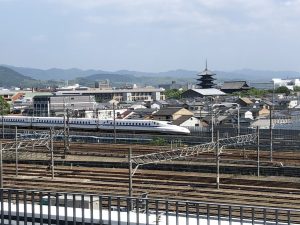
Within the lab, it seems that a combination of Japanese and English is spoken in the lab depending on the context. Japanese predominates in conversations while English is used as necessary for technical discussion. However, the lab members communicate with me in English because I have little to offer in technical Japanese, but I hope that I will be able to learn some aspects of my research in Japanese so that I would be able to give an overview if anyone were to ask. My lab mates seem interested in my background in that they always have some questions for me about my university life in the U.S. or about my involvement in supermassive black hole identification. We have even discussed my interest in railway transportation and for the first time, I heard that there are Japanese train fans that can identify the motor and manufacturer of a train based on the sounds. They have collections of train sounds; I hope to become more adept at identifying trains by only sound at the end of my stay in Japan. As my alumni mentor Julia Downing mentioned, the lab group goes to lunch with Tanaka-sensei, the Professor and head of the lab, and Naka-sensei, the Associate Professor, every day. At mealtimes, most of the students engage in lively Japanese conversations and it seems that there is little division between masters and doctoral course students as to each other, everyone uses the informal forms. However, my Japanese capability has no impact on my ability to carry out work in the lab, since I have numerous resources available and mentors who are more than willing to help.
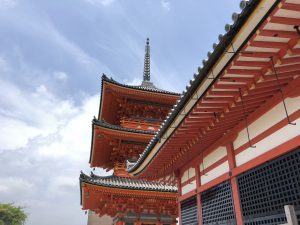
My housing location is a reasonable distance from the Graduate School of Science, where I am working. By bus, it takes around 20 minutes to arrive at the closest stop to the lab and about ten minutes of walking. Kusaba-san lent me a bike, but I have not commuted by bike yet, so I have yet to find what the time is by biking. My apartment room is compact although perhaps more spacious than the rooms in Tokyo and is hidden away from the main streets. Although the location is on the same street as Kiyomizu-dera, it is very quiet and convenient to the bus stop, supermarket, convenience stores, and numerous kimono rental establishments. The facilities including kitchen and washrooms are shared by the tenants of the apartment building, but since I share two meals a day with the graduate students in my lab, I have no need to use the kitchen. Because our location is so close to Kiyomizu-dera, there are always large volumes of tourists around the bus stop and thus I hear foreign languages about half the time I am crossing that intersection. Since this area has so many foreign tourists, I would like to observe where these tourists come from and how the Japanese local residents view these tourists depending on which country they represent.
I have already begun to identify where these tourists are from when I took my first weekend to walk around the neighborhood for the first time and head up the hill to Kiyomizu-dera, with the souvenir shopping streets, street vendors, and kimono outlets. Nearly anyone wearing a kimono and the vast majority of tourist seem to speak Mandarin Chinese, with the Chinese tone indicative of China. There were also numerous students on school trips to the area, from elementary school age to middle and high school. The students are easily identifiable by their uniforms and are usually led by a few teachers. At the site of the entry torii, it seemed the only Japanese remaining were from the schoolkids and the shopkeepers. However, enduring the masses of these tourists brings the rewarding view of the Kyoto cityscape coupled with the ancient history of the temple. At this higher elevation, the entire city is visible, and it was apparent that the city was located in a basin, surrounded by mountains, suggesting a humid and hot summer ahead. This skyline contrasts sharply with the Tokyo view, which has towers of varying heights. In Kyoto, buildings are generally no more than ten stories in height, and the absence of electronic billboards and bright-light advertisements was palpable, a result of the city’s strict regulations on outdoor advertisements in the effort to preserve Kyoto’s scenery which is prized as a cultural asset. The setting reflects the history of Kyoto as the seat of power in Japan as the imperial capital and the cultural heart of Japan.
Reflections on the Orientation Program in Tokyo
The orientation program was invaluable for forming and cultivating connections with other Nakatani Fellows including the Japanese cohort. The opportunity to explore Tokyo’s many districts as a group was a bonding experience and was an essential time to really get to know one another prior to heading to our respective labs around Japan. I broadened my insight into the history of Japan by understanding how the past connects to the present day bustling cosmopolitan of Tokyo. The Japanese classes, while quite long, was a rewarding experience in becoming comfortable with spoken and colloquial Japanese. In my Japanese classes at UMass, I had already learned the grammar structures and vocabulary covered in the AJALT classes; thus, I was able to productively use this time to train myself in speaking more naturally. While I likely may never achieve fluency, gaining the confidence to do so was an important part of the language acquisition process. The most illuminating components of the orientation program personally were the Takasaki outing with Prof. Sasaki, the University of Tokyo visit, and the opportunity to spend a weekend establishing new relationships with the Japanese Fellows. These three core activities constitute the three key elements of why I am here: history and culture, leading scientific research, and forming new bonds and networks. Through these experiences, the link between how ancient Japan developed into a world leader in pushing scientific limits that remains a bastion of rich culture became increasingly clear and as I learned more, Japan became increasingly accessible as its society opened up before my eyes.
Although I had prior knowledge of Japan’s excellence in precision, whether in being extremely punctual or in manufacturing mission critical precision systems, I did not quite believe the magnitude of this culture until arriving in Tokyo. After examining Japan’s history more deeply, I became especially taken impressed by how Japanese culture has allowed it to make progress in a self-sustaining manner. Reflected in the many museums we visited and even in the ancient temples, the Japanese acknowledge that their approach of learning from the best of other cultures and adapting it in application to their own society is how Japan has advanced technologically and socially. Japan does not allow external cultures to overshadow its own traditions; instead, Japan searches for the best in others and learns by example. While in many nations, a culture may potentially be adapted in its entirety including the possible shortcomings, Japan actively seeks to extract what is worthy and embrace that as their own. As a modern example, Japan’s automobile industry skyrocketed after studying the superb mechanical designs of German automakers. Even from the early Meiji period, Japan’s readiness to learn from others and integrate the positive aspects into its culture while preserving its identity is an admirable national trait that continues to propel Japan forward.
Because coming to Japan and Asia was a new experience for most of us, during the orientation program, there was a tendency to attempt to go to as many different places in Tokyo as possible in the shortest amount of time probable. However, I learned that I would rather select a few places where I would like to go and spend a significant amount of time in deepening my understanding about that place. I find significantly greater value in truly appreciating something than merely having a superficial experience driven by near instant gratification. For instance, I could spend an entire evening admiring and observing the sunset and the awakening of Tokyo at night. I could also spend an afternoon in the exquisite environment of the Shinjuku Gyoen Garden. Spending more time on a few activities allows me to have time to think through what I am observing, ask interesting questions, and hopefully learn something meaningful from the conclusions drawn. Understanding a place, let alone a people, requires significant investment of time and thought; personally, living in the center of metropolitan Tokyo was much too commercialized and fast-paced for me. The comparatively quieter setting of Kyoto affords me the opportunity to think and understand. Although I have a language barrier, I hope to gain insight into how the Japanese think and the role that culture plays in cultivating behavior, especially with the honne and tatemae. I hope to accrue enough experience in interacting in Japanese to further appreciate its role in shaping relationships and preserving a culture.
Research Project Introduction
The scheme of my project is to make monolayer samples of MoS2 and transfer that to a crystal substrate LiNbO3, and then run terahertz experiments for characterization. In particular, we are interested in measuring the transmittance using the terahertz microscope. Since the special substrate has never been used with MoS2 and because the sample of MoS2 is difficult to target on this particular substrate due to its visible transparency, these steps may take longer to complete. After making at least a 10-micron square sample of monolayer on LiNbO3 substrate that is necessary for the terahertz microscope, I will begin the terahertz experiments. I will use standard mechanical exfoliation to fabricate monolayer MoS2 from the bulk material. Then I will use Raman spectroscopy to determine the layer number of the target sample by measuring the Raman modes and the frequency differences. I will also look for other few-layer samples and run the spectroscopic test to observe the relationship between the peak frequency, frequency difference, and thickness of the material in comparison with the values given by the literature.
On my second day, I made monolayer MoS2 successfully using mechanical exfoliation from bulk MoS2. After checking the sample for possible monolayer or bilayer fragments with an optical microscope, the layer was placed on an n-type silicon substrate. Then I measured the photoluminescence of the material with a laser, verifying that the sample I had made indeed was monolayer and conducted Raman spectroscopy on the material. I then conducted a preliminary analysis of the data, with the Raman shift plot showing two Gaussian peaks and the photoluminescence showing a single peak. Kusaba-san patiently guided me through the fabrication process, step by step, even with my numerous errors, including losing an excellent sample by destroying the substrate that I had made; however, I was eventually able to obtain a monolayer area with a length greater than 30 microns.
These first few days in the lab were set aside for me to be trained in the standard experimental techniques of monolayer material fabrication before I begin work with novel monolayer substrate combinations. I must be able to reliably make the monolayers and integrate them on substrates before I can proceed to the next step. I continued Raman spectroscopy on my samples, selecting positions on the MoS2 of varying layers the next day. Using the Raman shift data, I verified that I have sample regions for monolayer, bilayer, and trilayer MoS2 which closely aligned with the frequency differences given in the literature. It is possible to estimate the layer number by using the optical microscope and I trained with Kusaba-san to be able to identify potential thin layer areas that could result in a sufficiently sizeable monolayer sample. By the end of the first week, I was expected to be able to make samples, run the spectroscopic test, and analyze the results, which I carried out on Friday under the careful eye of Kusaba-san and Arikawa-sensei.
Tentative Timeline
- Week 1: Fabricate monolayer, bilayer, and trilayer MoS2 using standard techniques
- Week 2 & 3: Make sample for THz spectroscopy using special substrate LiNbO3, may take longer since this procedure has never been done before
- Week 4: Attempt to undertake first THz experiment
- Week 5: Mid-Program Meeting and continue experiments
- Week 6 & 7: TBD experiments
- Week 8: Finish tasks, abstract, and poster preparation
Question of the Week
With over 29 million international tourists that come to Japan each year, how do the Japanese perceive tourists based on their country of origin? The Japanese government hopes that the tourism industry continues expanding; however, how do the Japanese view this besides being an economic driver?
- Living in Kyoto, you will have a first-hand view of the pros and cons of the increasing numbers of international tourists, particularly from China, in Japan. You might actually talk with your lab group about this over lunch. Share that since you are living in an area where there are many tourists you really have seen how crowded it can get. What do they think about tourism in Kyoto and do they have any tips for avoiding the massive crowds or suggestions of less commonly visited places to go in and around Kyoto?
- For more on this, see the Tourism in Japan: Growth and Impact section on our Travel in Japan resources page.
Week 05: Cultural Analysis – Life in Japan
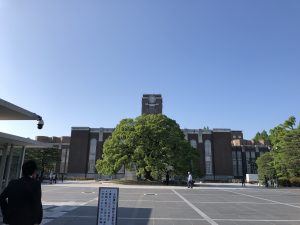
Having an international background with a global network of friends has enabled me to adapt into new cultures more easily and identify intercultural differences as they arise. In many cases, these cultural differences become fairly predictable if you have experience or if you begin to understand a culture at a subtler level. After leaving the lab space late one evening, I was talking to one of the Japanese students and discussing what work I was carrying out here. The Japanese student asked me if I would be continuing to work that night and I replied that I would be heading to dinner soon. However, he interpreted this as an invitation and conveyed that he had plans to eat with friends. Since I had been working twelve hours, I was using this as a convenient reason to exit the workplace, I had intended to excuse myself to head home. I understand the tendency of the Japanese people to be very inviting, at least outwardly, and I recognized the misunderstanding immediately and clarified that I would be going by myself. At this point, he realized that my intent was to head back from campus although I did not directly indicate this. By communicating in a very clear manner, any potential misunderstandings especially of more significant magnitude can be diminished or avoided altogether. Because the student perhaps had wanted to return to campus for additional work in his lab afterwards, I did not wish to frankly express that I was done for the day especially since working late into the night in the labs of my building seems to be typical. It seems characteristic for the Japanese people to assume that you may be extending a tacit invitation even when not directly stated because many aspects of communication in Japan and in Asia are nonverbal. Cultural assumptions and expectations are adhered to and particularly in Japan, it may be unusual not to invite someone else to join you in doing something if you are in the presence of this person. While this brief exchange was uncomfortable, for both me and the Japanese student, I was quickly able to ameliorate situation by being clearer without being overt. This balance between too much and little information is a tangible feature of the Japanese language and just how much is necessary to express an idea
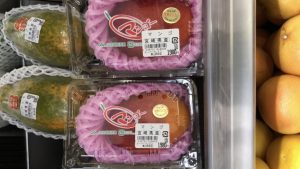
Situations such as these illustrate that communication between foreigners and Japanese is a much different experience when English is used in place of Japanese, and demonstrates the cultural implications carried within a language. While this came as no surprise to me, I found that using English in a Japanese way—that is assuming Japanese cultural norms within the English context—does not necessarily lend itself to the same meanings. English and Japanese are very distinctive paradigms that are closely tied to their root cultures, which may have led to how the Japanese student thought I had been implicating an invitation when in fact I thought I was attempting to be as clear as I could be. Should a similar scenario arise, I should use Japanese as I have sufficient proficiency in Japanese to handle such simple exchanges. Many English expressions do not have a translatable equivalent in other languages and being aware of these gaps can considerably reduce the rate of misunderstanding.
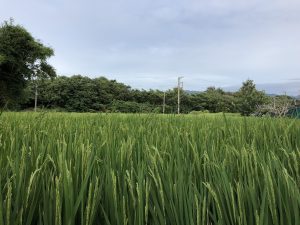
I’ve also noticed that approximately once a month, undergraduates come into the lab to perform some experiments or receive hands-on training from the graduate students. All of these undergraduates are either entering or in their fourth year (B4), were majoring in physics, and had plans to enter the graduate school here. This experience in the lab allows them to preview graduate student life in the lab which they would like to join while preparing them in basic techniques so if they are admitted to graduate school, they can begin right away. However, the undergraduate students only stayed for about a couple of hours before they that they had “given up.” It seems that undergraduate students in the lab are treated quite differently in the research lab than the graduate students. In the United States, undergraduates often operate independently on a project under the supervision of a graduate student or the professor but it seems that since undergraduates start so late in the lab in their college careers that their experience in the lab is mostly intended for training to become a graduate school student. Thus, all of the undergraduates I have encountered in the lab are there to develop the lab skills needed for independent work as a graduate student. This contrast with the American undergraduate student in a research lab provided insight into the differing approaches to research training for the common goal of producing adept scientists.
- For more on this topic, see our Undergraduate Research in Japan and Education in Japan sections on our resources pages.
Research Project Update
After completing the standard fabrication of MoS2 monolayers on silicon substrate, I have begun to work on making monolayers to be placed on the new LiNbO3 substrate. This process is much more challenging than working with silicon because LiNbO3 as previously mentioned is essentially transparent to the eye. By optical microscope, the detection of the monolayer target requires scouring the surface for nearly invisible traces of material indicative of thin layers. Adding to the challenge, the monolayer must be placed on the orientation of the substrate, since one side has a highly reflective coating and the other has an antireflective coating. The sample must be transferred onto the highly reflective coating for the purpose of terahertz microscope analysis. However, it is very difficult to distinguish one side from the other and the one of the ways to observe the difference is to use a pair of white tweezers and determining how it reflects on the surface of the substrate. Because the terahertz microscope has a large beam diameter, I also need to make a sufficiently large sample of freestanding monolayer material to be placed on the substrate that is well-isolated from the bulk sample fragments. This requires me to manually remove the bulk parts or continue the exfoliation process until a large piece of monolayer sample can be found.
The obvious next step is to take the spectra of the substrate to run a background subtraction on the Raman spectra of the monolayers to study the profile of the monolayer on this new substrate. However, since the instrumentation was being used by many of the graduate students, I was not able to take measurements as quickly as I would have liked but I was able to use the flexibility to check out what other papers related to monolayer MoS2 have been published besides those that I was given. In addition, I continued to look for large monolayers in the fabrication lab.
Since relying on chance to obtain a sample is not a dependable method in making a terahertz worthy sample, I asked if I could test out some alternatives for obtaining these samples more resourcefully. One of my samples had a large monolayer area that would be ideal for the terahertz microscope if only it were not adjacent to the bulk. After consulting with Kusaba-san and Arikawa-sensei who informed me there was not really a technique for manual bulk removal so close to the monolayer sample itself, I thought I would reattempt a strategy that Kusaba-san said he had tried before but for a different application. I fixed a contraception to the optical microscope where I could remove the bulk using a needle mounted on an adjustable platform. By moving the needle across the surface of the sample, the bulk fragments could be more or less removed before transferring the material onto the crystal substrate. However, the needle was quite blunt in the magnification of the microscope and in attempting to remove the areas around the monolayer, I inadvertently removed the monolayer I was trying to isolate, which meant I had to continue looking for monolayer potential areas again. With this experience, I also realized that the needle must be much finer for bulk removal to work. Naka-sensei happened to have a very thin and fine needle which she allowed me to use but seeing that the needle was so thin that it had essentially no holding strength, Kusaba-san and I devised a new tool which I could mount onto the movable platform next to the microscope and cut the needle leaving only the tip of the needle so that it would not break when moved across the sample. Kusaba-san helped me machine the part in the workshop and I soldered the needle onto the lever and at the end of the session I had a tool I could work with to hopefully expedite the tedious process of looking for large, isolated monolayers. This thin needle removal of the bulk was a much safer and effective method in removing the material close to or even bordering the monolayer area. By the end of the week, I was able to extract a sample of monolayer material that was well isolated from the bulk material using the needle I had made. I will then transfer this onto the crystal substrate, confirm the monolayer Raman spectra, and then receive training on using the terahertz microscope system in preparation for experiments.
Question of the Week
This week many of us in the Kansai area experienced our first earthquake in Japan, a magnitude 6.1 with an epicenter near Osaka. However, the infrastructure damage seemed manageable and was handled well. Since Japan experiences such geological events frequently, are earthquakes of one like this perceived as “normal” and how typical is it that people head to work anyway?
- Japan is a world leader in disaster preparedness and response, particularly regarding earthquakes, tsunamis, and typhoons. This makes sense as Japan is one of the most seismically-active places in the world. In Japan, regular safety training and drills are held at all levels and these are take very seriously as there is a very high likelihood that at some point in your life you will experience a major earthquake. This is one of the reasons that places like the Life Safety Training Center that we visited in Tokyo exist in Japan and why cities in Japan have very detailed emergency preparedness handbooks and resources. Safety is taken so seriously in Japan, that one of the most detailed and helpful sites for foreign residents in a city is usually the English website or pamphlet on disaster preparedness as that was typically the very first thing that was translated into English for foreign residents/visitors.
- It may be more accurate to say that a 6.1. earthquake is not unexpected rather than to say it is ‘normal’. Just within the past 10 years there have been major earthquakes and disasters in Japan including the 2016 Kumamoto Earthquake and the 3/11 Great East Japan Earthquake. These are events that had some impact on everyone in Japan today, whether they were themselves affected, their family/friends were affected, or just the entire nation coming together to help support and respond to the disaster in some way. Many of the emergency response procedures that were implemented and used successfully during these events, arose directly out of the 1995 Great Hanshin Earthquake in Kobe. So, after each disaster, the response is reviewed and evaluated and new measures are taken to be even more prepared for next time.
- Emergency preparedness and training is not an abstract concept in Japan. It is something that is a real part of someone’s day-to-day existence and, as such, the infrastructure surrounding disaster response such as having civilian patrols/response teams, designated meeting areas and designated shelters that are well-stocked, or systems in place to quickly shut down gas lines to limit fires from broken gas pipes after an earthquake are part of standard/built-in fail safes in Japan and are administered at a governmental (city/prefecture/national) level. In the U.S. we do have the Federal Emergency Response Agency (FEMA) but they must respond to disasters across a huge geographic region and much of the local/immediate response is coordinated by non-profits in the U.S. such as the Red Cross. So, there is just a different approach with a higher degree of standardization, mandatory training, and even a National Disaster Preparedness Day in Japan on Sept. 1.
- For more, see the section on Natural Disasters on our Safety in Japan page.
Week 06: Cultural Analysis – In the Lab
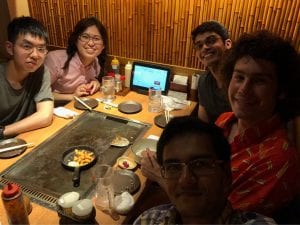
I have been fortunate in my research group to be among Japanese students who have an excellent working proficiency of English and are enthusiastic in using the language. Because of these students, I have not had a significant intercultural miscommunication in the group. Impressively, although expected, their technical scientific vocabulary is sufficient to be able to express key instructions that I understand easily. Any communications mishaps are self-induced as a result since anytime something is unclear, the Japanese students would query with a “sorry?” or “pardon?” which enables me to use other words to re-express what I wanted to get across. Addressing a potential for misunderstanding in this way is much more effective than waiting for a misunderstanding to actually arise, and by expressing their difficulty in understanding what I may be trying to say, they are also expressing a self-humbling consideration, that it is their inability to comprehend my words where in reality, I may have spoken too quickly or used a long and complicated sentence.
I have found that if I speak “normally” as a native English speaker would and use complex sentence structures with many modifiers, the meaning of the entire sentence would become rather incomprehensible to most students here. The Japanese students are up front if they have doubts about what I am attempting to communicate, and I also restate what I believe they mean when I am unsure if I am correctly understanding them. This greatly reduces the chance of misunderstanding although it may take a few more verbal exchanges to complete the conversation. In a non-English environment, it is best to break down one complex sentence into several small phrases that have simple structures, which would make communication more natural when you as the speaker do not need to doubt whether the person you are talking to is understanding or not and would be a considerate approach to carrying conversations where it is evident that English is not the primary language of the interlocuter. Oftentimes, when I venture to translate my own words in Japanese, I receive something like “you have great Japanese” in English which is an ideal opportunity to return the phrase 英語は上手ですね in complimentary Japanese spirit.
I also learned why the Japanese college experience is much more laid back than the typical American college of similar caliber. Based on my past conversations with Japanese undergraduate exchange students at UMass, I learned that for the most part, employers do not place much weight on the student’s major because most companies train employees themselves. However, I had many conversations regarding the education career leading up to a professional scientific career in Japan with the graduate students and their motivations. If a student wishes to enter graduate school in Japan, passing another entrance examination is the only real requirement for admission. I was especially surprised that graduate school admissions do not factor undergraduate grades as a standard of admission. Because undergraduate coursework performance is measured by an exam, I see why the Japanese college experience is much more focused on extracurricular activities such as clubs than academics. This makes the undergraduate experience significantly lower stress and allows students to focus on enjoying a college life that is a time for them to explore and seek their personal and professional interests.
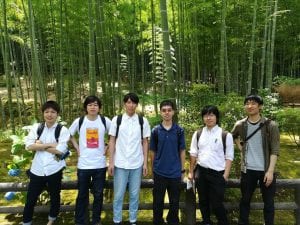
The academic faculty structure is also slightly different from what I have experienced at home. Full professors typically have teaching commitments while tenure-track assistant-level professors have more of a research emphasis. This is often the reverse at U.S. universities, where full professors teach classes infrequently while assistant and associate professors are assigned to the largest of 100- or 200-level lecture classes. For aspiring career faculty members who are climbing the tenure ladder, their years as assistant professor can be pivotal for their careers when they must balance producing their best research work while maintaining high student evaluation approval to retain their positions. While the professoriate is a career that is highly competitive worldwide, American professors are under greater pressure to perform exceptionally to merely keep their positions than their Japanese counterparts. While the administrative demands that tenure-track American faculty members experience may result in large volumes of papers, many of these papers have little value in the greater scientific context. The Japanese approach to academia of cultivating the faculty from the assistant-level working in a lab headed by a highly experienced full professor and being promoted with increasing years of expertise seems to be an alternative to the American academic system that has proved its excellence through their scientific contributions in Japan and around the world.
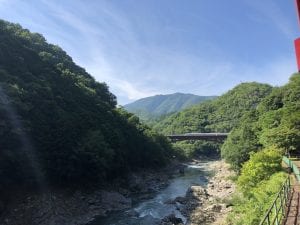
I believe my biggest personal accomplishment outside the lab is being able to navigate the public transportation system in Kyoto and Osaka despite having little familiarity with the city itself. I am able to get myself to destinations and I have yet to take the wrong bus or train. Because public Internet access is usually inaccessible and because I have no mobile service, I am usually unable to rely on Google Maps or similar applications for logistical advice. As the bus system is predominantly Japanese, with English translations being simply the romanization of the Japanese place names, I have been able to recognize more kanji at a faster pace, so I can quickly decide which bus I need to board. In the U.S., I rarely have the opportunity to use the city bus and, because of this, I did have an aversion to getting around by bus. This has changed since coming here since taking the bus to commute anywhere in the Kyoto area has increased my comfortability with bus transportation. Public transportation is often the lifeblood and pulse of a city and by becoming integrated into this setting and flow, I feel that I am more of a member of the city rather than a tourist. The perspectives that a tourist receives from a mere few weeks in a country compared to living and working for a couple of months in one location yield diverging perspectives and insights into the culture and society in that place. As one of the most culturally rich areas in Japan, even the process of integrating into Kyoto as a temporary visitor with elements such as mastering the bus network is a rewarding experience.
There are certainly a few challenges that come with working in an experimental laboratory coming from a theoretical background compounded by the setting of the lab in Japan. Not the least of which is that my understanding of the language likely would not even match that of a Japanese toddler. Another challenge that I have enjoyed throughout my time in Japan is how Japanese people use Japanese to speak to me by default. Oftentimes when interacting with service employees who repeat the same phrases repeatedly, there is no issue. However, my lab members and I regularly encounter vocabulary voids where I cannot contextually guess what the other is trying to say and where they cannot necessarily understand my questions. One unintended strategy that has worked for me in the past is to adapt the same style of speaking English as they do to ease their ability to understand me. When surrounded with native Japanese speakers, I have subconsciously realized that my communication is actually clearer when I use a loosely katakana version of English or leave out certain articles in my sentences. Having lived in many places, I have a tendency to adapt the local language style and thus, it was natural for me to unintentionally communicate with them in “Japanglish.” Although I certainly do not encourage this practice in any way as it doesn’t benefit either party from a language learning standpoint, this was the fastest way to communicate when what I was after was the content of the message rather than the conversation itself.
Research Project Update
I am progressing gradually but steadily with the lab work and somewhat unexpectedly, I have been working slightly ahead of our anticipated timeline. I believe this may be a product of working long hours every day, as the timeline may have reflected the progress had I adhered to the standard American convention of a nine to five workday. Although this was another challenge—staying late in the lab rather than leaving whenever I completed the work of the day out of respect, this 頑張る work ethic has allowed me to make gradual progress without the sensation of being actively rushed. However, the subsequent and core part of the project is yet to be performed and the terahertz microscope setup is a highly complex system. While I am looking forward to this interesting challenge, I am not certain what to expect with regards to timing of the experiments as the rest of our plan is carried out. Since Arikawa-sensei mentioned that these measurements with monolayer samples on lithium niobate have never been taken before, this new territory may be a slightly slower process and I anticipate the additional time allotted for this part will be necessary.
Although the earthquake this past week was significant, fortunately the lab instruments were unaffected, and I was able to continue what I started last week, isolating a monolayer sample. I made a second sample and transferred it onto the LiNbO3 substrate, but the sample was only about 10 mm2 and thus was challenging to target on the spectrometer especially as the monolayer is nearly visibly transparent on the crystal substrate. To ensure that the sample would not be too small for the terahertz microscope, I continued to look for additional potential monolayer sample from my bulk fragments. Soon enough, I found a relatively large sample that exceeded the dimensions of the first sample I had and proceeded to clean it with a needle. When I had prepared both samples for Raman spectroscopy, the resulting spectra for the smaller sample did not show any Raman modes. There are two reasons why this may have occurred: the sample was so small that it was very difficult to target with the laser beam or the laser happened to target a hole in the sample, capturing the spectra of the substrate background instead. In any case, I obtained the desired spectra for my second, larger sample for the purpose of using the terahertz microscope. Because to verify the layer thickness of the sample I need to measure the difference of Raman shift between the two peaks on the spectra, while waiting for the instruments to become available for my use, I wrote some programs which will aid my verification analysis by allowing me to go through that process simply by uploading data and running the program. At this point, I can independently move through the initial stage of the experimental pipeline from monolayer fabrication to Raman spectroscopic analysis and am now studying the terahertz setup.
Towards the end of the week after I finished readying my samples, Arikawa-sensei introduced me to the terahertz microscope setup. This instrumentation system was, as I expected, much more complex than the ones I had been working with before. The intricacies of the laser setup in obtaining terahertz waves was a reminder that I still had a while to go in understanding the moving components of the system before I could carry out interesting experiments and describe the process scientifically. Starting up the laser itself was a nontrivial process itself let alone taking measurements. The terahertz radiation is generated through a lithium niobate crystal with femtosecond laser pulses and the response from the material is measured through a second laser incident on the underside of the sample. The sample must first be aligned in the correct orientation such that the terahertz radiation is incident to the substrate at the appropriate angle and using the microscope, the isolated monolayer must be found and targeted, especially challenging if the monolayer has a small surface area which is difficult to discern through the scope. Arikawa-sensei helped me take initial image data on my sample by stepping me through the process, including the monolayer region and the substrate as the background and I began to familiarize myself with image processing using ImageJ, a tool that I was first exposed to in exoplanet identification. Because the terahertz data is collected in the form of image frames at tunable time steps that directly affects the electric field measurement, I also learned to use the custom Igor package that a former lab member had assembled to process the images with coarse graining, Fourier transform, and time slicing.
After closely examining the image sequences, it seemed that the MoS2 was not quite visible on the microscope. This may be a result of very little or no doping of the semiconductor from the substrate. The lack of doping would cause the sample to have a less than optimal metallic content, which is what allows the material to be observed with the terahertz waves since metal absorbs the terahertz radiation and should result in an observable shadow. For the second set of measurements, Arikawa-sensei adjusted the optics such that the focus was at 20x rather than 5x and allows the targeted optical area of the monolayer to be entirely encompassed within the terahertz beam. Thus, I took another set of measurements at greater accumulation times with the bulk, background, and monolayer parts of my sample. Taking the terahertz response requires a considerably longer time particularly when the accumulation and number of frames are increased and has proved why obtaining a large monolayer sample greatly makes this process less tedious and ambiguous. I will continue to obtain new data and analyze them concurrently leading up to the Mid-Program Meeting, where I hope to have an appreciable image to present, and if necessary, prepare a new sample for more testing.
Question of the Week
Club activities in Japanese universities are a significant part of student life whereas this may not be true at every U.S. university. However, there are also “tennis circles” that do not even own a racquet. How do these circles compare to the American equivalent of social clubs and societies?
- University Clubs/Circles: College Life in Japan (Japan Info)
- Clubs and Circles in Japanese Universities
- Choosing Between Clubs and Circles in Japan (Blog)
- For more on this, see the section on Universities in Japan under the ‘Education in Japan’ section on the Life in Japan resources page.
Week 07-08: Mid-Program Meeting & Research Host Lab Visit
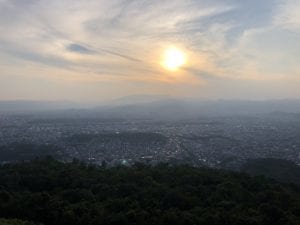
The Monday preceding the Mid-Program Meeting, I hiked Mt. Daimonji (大文字山) with a few labmates to take a short break from the office for a couple of hours before coming back at night to continue work. The observation point on the mountain was around 330 meters and thus made for a short yet rewarding climb. This particular mountain is unique because near the summit there is a large inscribed triangle visible from the base where the trees have been cleared. In August, there is a festival called the Gozan no Okuribi where the character 大 is lit up in a bonfire within this triangular region. There are four neighboring mountains that also light up with bonfires that take the shape of characters for the festival. At the elevation of the observation point, nearly the entire area of Kyoto can be seen and on a clear day, a few buildings in Osaka may also be visible. After heading to dinner, Kusaba-san kindly showed me around the central Yoshida campus, particularly the International Science Innovation Building, a hub for research and development collaboration between leading companies in the industry and academia. Within this complex, there was a student makerspace with several facilities that Kyodai students could use, including virtual reality engineering computers, 3D printers, and laser cutters. Such spaces were located across from company offices, making for an ideal cooperative environment. The opportunity to see the common facilities and vast resources available at Kyoto University only served to justify why the school is arguably the No. 1 university in Japan and has more international collaborations and research impact than the University of Tokyo.
Reflections on the Mid-Program Meeting
Because I am located in Kyoto and keep in touch with the Japanese Fellows in the area, the Mid-Program Meeting seemed like a reunion of friends at home. The first day of the Mid-Program Meeting began in the evening after the U.S. Fellows had all arrived at the Kyoto Travelers Inn to go to another joint dinner with the Japanese Fellows who had already attended a day of seminars and lectures. Since I did not need to travel, I spent the day hiking Mount Inari and sightseeing at Fushimi Inari. The area was a short train ride away from Kyoto Station but was, as expected, filled with tourists most of whom were foreign. At the entrance of the series of torii, hundreds of tourists gathered to replicate the iconic photo that is shown in nearly every guidebook to Japan. However, walking deeper into the mountain along the torii path, the number of visitors thinned and soon enough, I became the only one in sight on the trail. I walked to the outlook area where part of Kyoto city was visible and then hiked through the loop trail over the summit, where I realized there was no view. Although there was no sweeping view at the summit, walking through the trails was a true torii experience, where there are estimated to be 10,000 in that mountain alone.
That evening, the entire group of 2018 Nakatani Fellows headed to the Kyoto City Zoo for a networking dinner where I was able to connect with all the Kyoto and Osaka area students and answer questions they may have regarding research in the U.S. or undergraduate student life in a typical U.S. university. Discussing the role of the university in students’ lives in Japan compared to the United States was particularly interesting because clubs and circles seem to play a much larger role in Japanese universities than in their American counterparts. At Kyoto University for instance, tennis circles are a euphemism for social mixing clubs. These tennis circles play the role of American fraternities that are common at most U.S. universities especially on the weekends and hence most members of tennis circles do not even own a racquet and may not even know how to play tennis. Only a Kyoto University student would know which “circle” actually was interested in playing the sport of tennis. Shortly after dinner, nearly everyone in the group went for a joint karaoke night in the Kawaramachi area. Since we were a sizeable group, we had three rooms in which we were free to rotate throughout the night. The U.S. students selected mostly American songs while the Japanese students chose popular Japanese music. It was an interesting mix and a unique opportunity to see the Japanese students in a more relaxed setting. These types of activities foster our network and it was quite a memorable experience.
The next morning, we had our debriefing where we were able to share our living and studying experiences at our respective host labs, universities, and communities. It was surprising to hear how everyone was having such different experiences contrary to what I expected. For instance, some lab groups seem to function very informally and have laidback schedules, a sharp difference from my group which almost always has students in the lab twenty-four hours a day and seven days a week. However, the distinction between the two flagship Japanese universities, Kyoto University and the University of Tokyo, and the other schools was made clear. The Japanese students at these two schools seemed to have the most intense working hours and were most eager to use English in the lab whereas in some of the other universities, students may be hesitant to speak with us. The styles of work were somehow not the same and our sharing during this session demonstrated these subtle details.
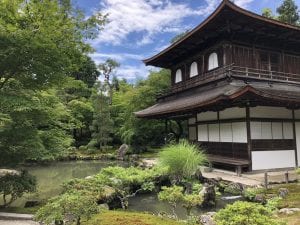
After the debriefing seminar, we regrouped with the Japanese Fellows once again to send them off back to their home universities for the final time. Some of the Japanese Fellows would join us for the afternoon activities but many had to depart as they had classes in the morning on the next day. The U.S. Fellows were gifted yukata, a traditional Japanese garment that is a casual version of the kimono. We were helped into getting dressed in the yukata and after having our portraits taken, we went to experience an abridged version of a traditional Japanese tea ceremony, the Way of Tea. With an introduction to tea ceremonies given during the Tokyo orientation, I knew how rigid the structure of the ceremony could be. However, our hosts generously allowed us margins of errors and were not too exacting on the ‘standard operating procedures’ of tea ceremonies which was relieving. Tea ceremonies are a medium of Japanese hospitality in which the guest is shown honor and reverence through tea service. One of the key points of experiencing the Way of Tea is the heart that is devoted to making the tea. Whilst using the whisk to stir the matcha powder in the hot water, the host is only thinking about the guest and how to make this tea the best it can be for the guest. The exquisite sweets served before the tea was also an impressive part of the ceremony. The dessert was so fine, decorated to resemble the Milky Way with gold and silver flakes, that it seemed more like a decoration than an edible confectionary. After learning about the etiquette of being served tea, it was our turn to serve tea to the staff and Japanese Fellows. These longstanding traditions have so many tacit protocols that I doubt I would ever be comfortable with even when I learn about the culture since I am approaching these exposures with an analytical rather than a personal perspective. I have great appreciation to have this extraordinary occasion to experience a significant slice of Japanese culture that even most Japanese today may not have had a chance to experience.
On Monday, we had our Mid-Program Meeting research introduction presentations. Several of us already had preliminary results but many others came with topical introductions to their host lab’s research areas. It was interesting to receive a broad survey of the different areas that the other Fellows are working in, from biomedical engineering to chemistry and physics. Upon entering the physics major in many universities, we often do not have the chance to ever interact with a biologist or chemist again especially if we enter deeply technical areas in the field. The array of sciences presented here is a refreshing way to reconnect with the other sciences and witness how these different areas do have some mutual dependency. Having interdisciplinary perspective in research is derived from inspiration in other fields, including the life and medical sciences which all too often seems distant from physics. We received a lab tour of iCeMS, a collaborative interdisciplinary institute aimed at studying cell-material sciences, including the Kamei Lab, the Furukawa Lab, and the Ohton Wang Lab. This collaboration across life and physical sciences was manifested in our visit to Sysmex Corporation in Kobe. According to one of the research managers, within the research division, the company mostly employs physicists and biologists. These physicists work with life scientists to produce medical instrumentation and similar proprietary products that require expertise in both physics and cell or molecular biology. Interdisciplinary collaborations such as these are grown from meshing fields together during a student’s training years and allowing a physicist to be exposed to biology can result in valuable inspirations that accelerate the progress of fields as ostensibly distant as medicine.
We also had the opportunity to participate in an exclusive tour of Kyoto’s important shrines and temples, many of which are limited in access to tourists. We first visited the Kamigamo-jinja Shrine in northern Kyoto, a Shinto shrine designated as a UNESCO world heritage site which predates the 7th century. One of the oldest shrines in Kyoto, we were allowed to enter the deepest part of the complex where foreigners are usually not permitted. Because Horikawa-san has been involved with the Kamigamo-jinja Shrine, we like the past few years of privileged Nakatani Fellows, also had these opportunities to visit areas usually closed to tourists. We then walked over to the Umetsuji-ke, a private residence that was built for priests of the Kamigamo Shrine. Part of the house was taken from the former structure of the imperial palace and included the study room of the emperor. This residence was unique because there were inconspicuous building features that made that particular room distinctive. For instance, the ceiling wood beams run in the direction towards the alcove where usually there is some installation of manuscript or a calligraphic cloth. These beams typically run perpendicular to this direction because misfortune was considered more likely if the beams run in the direction toward the alcove. Another feature is the rare quality of the wood material holding the house together. The wood was taken from the very core of massive, old trees and are known for their durability and consequently, are still sturdy today.
After lunch, we headed to the Shokoku-ji Temple, one of the most prominent Zen temples in existence. This temple is only open approximately six weeks a year to visitors and we were able to visit parts of the site that were closed to tourists. Because of the limited accessibility of this important temple, there were little to no tourist presence here, an issue that affects most temples and shrines in Kyoto. Within the Hodo Hall, the oldest temple hall of its type in Japan, there was a painting of a powerful dragon completed by artist Mitsunobu Kano in the early 1600s. Walking around the hall, the dragon’s eyes seem to follow you around. Because of the unique acoustics of the wooden ceiling, there is a particular location where if you stand and clap, the so-called “dragon’s cry” can be heard as the reflection of the sound reverberates from the slight domed circle where the dragon is painted. We also had the opportunity to visit the restored bathhouse, where visitors are not permitted to enter, where the monks would bathe to achieve enlightenment. The structure of the bathhouse revealed that heated floor technology has been around for centuries longer than electronics—when the bathhouse was in use, hot water overflow and drainage would flow into a channel running beneath the wood flooring which would create uprising steam, heating the flooring panels. This clever engineering ensured warmth in the bathhouse in the cold months and exemplifies Japan’s tradition of incorporating artistry with functionality.
Seeing the Japanese Fellows again was much like seeing the U.S. Fellows, more of a reunion rather than a first or second meeting. Although several weeks have passed since the Mount Fuji joint outing, meeting each other for the second time reinforced the connections we had and strengthened our network. For those of us who have met with some of the Japanese Fellows in the interim, the additional time together was an invaluable opportunity to establish closer ties and is a unique feature of this program that motivated me in the first place since it can be challenging to seek out undergraduates in a predominantly graduate student laboratory. I have plans in place to meet with a few of the Japanese Fellows once again and have maintained nearly regular contact with many of them in this area. One of the upcoming highlights that is occurring this month in Kyoto is one of Japan’s most famous festivals, the Gion Matsuri, which I heard from the graduate students in my lab is a very congested but unique festival experience. I may see this festival with one of the Japanese students here.
Research Presentations at Kyoto University
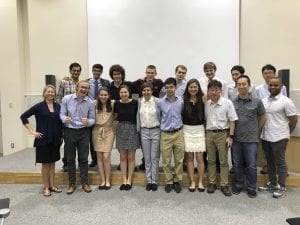
Giving the introduction to research presentation seemed like a routine experience. I have given a couple of scientific talks before and these are straightforward if the presentation is on the work that I have done. Although I do not have any background in solid state physics, it was not difficult to discuss what I had done and expounding on these results. The usual challenge is the preparation behind the presentation, the ability to explain technical content in an accessible manner. The preparation is by definition a type of progress check itself as it is important to anticipate the variety of questions that the audience may have. Prior to giving the presentation, I had only went through it once and had significantly exceeded the five-minute time limit, but during the presentation, I was able to communicate the key points across within the time limit. This five-minute talk was a reminder that giving brief presentations is much more challenging than long talks, since the preparation requires the presenter to prioritize certain points over others and be able to express these points succinctly and clearly. However, while five minutes would be a reasonable time limit for truly introductory presentations, since I had results to discuss, I was not able to treat my analysis of the results as thoroughly as I wished, and this may have created some gaps of understanding in the audience that I was not able to fill. Given the questions asked afterwards, I would have liked to explain the terahertz microscope system, but this alone would have taken more than five minutes. If I were to give a similarly short presentation, I would simply forego the sweeping introduction and discuss the results, and if the audience have any background questions I can address those on an individual basis. This would allow me to explain my results in a more appropriate manner. Despite the brevity of our presentations, I had a great learning experience listening to my fellow presenters and seeing what themes in current research is being pursued in Japanese labs today.
As with presentations I have done in the past, this presentation was more of a self-evaluation of not only how well I am progressing but more importantly, how comprehensively I understand what I am doing. Being able to communicate this becomes a byproduct of solid understanding. I plan to study the terahertz generation methodology and the instrumentation more because I received some questions about this during the Mid-Program presentations. While I am confident in discussing what I have done and interpreting the results, the questions revealed to me that I do not understand the instrument as much as I should to be able to discuss it at length. For instance, I was not as precise as I could in describing how the terahertz microscope worked and why the spatial resolution is what it is. Fortunately, the inventor of the terahertz microscope located in our lab, Prof. François Blanchard of École de technologie supérieure in Montréal, Canada is visiting for the coming month and I will have the opportunity to work with him on the terahertz experiments and hopefully gain more understanding of the instrumentation as he works on fine-tuning the system.
Research Project Update
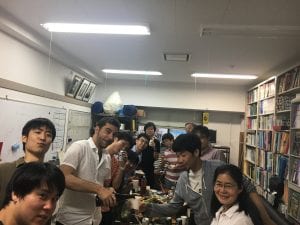
Prior to the Mid-Program Meeting, we changed the material to another TMD, tungsten diselenide (WSe2) because this was the only doped TMD in the chemical stock and it would be valuable to compare the terahertz response of the doped and undoped TMDs. This material is an n-type semiconductor. I obtained additional LiNbO3 substrate and deposited bulk WSe2 for Raman spectroscopy and THz microscopy. As presented, the WSe2 seemed to show some response as shown with the electric field measured by the microscope but was ambiguous and we cannot be sure if this is actually the sample even despite the similar physical dimensions. After returning later in the week, Arikawa-sensei informed me that the terahertz microscope resolution had been changed to 5 microns, which makes even smaller sample sizes possible. Because the elemental crystal substrate being used and bulk WSe2 are limited in quantity by high cost, we plan to use the same samples under the new spatial resolution of the terahertz microscope. After this, we plan to conduct some terahertz pump-probe experiments, which I will discuss with Arikawa-sensei when he returns.
Week 09: Research in Japan vs. Research in the U.S.
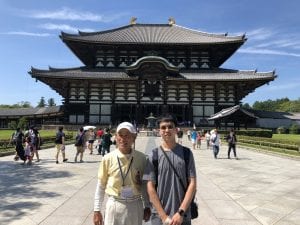
While there are no discrete rules in the Tanaka Lab at Kyoto University as previous visiting students have indicated, there are a few tacit standards that members abide by that are generally uncommon in the U.S. This lab group for instance always addresses its members with certain honorifics just as I expected. Usually, the honorific used is general –san but professors often use the –kun suffix when directing their dialogue towards students. Tanaka-sensei and Naka-sensei are always addressed as such, sensei, and although they are warm and easy to speak to, the gap in seniority and rank is always perceptible and the respect yielded to these two senior professors is tangible. However, there is one exception. One of the postdocs is known to call Tanaka-sensei by his nickname followed by –chan and it seems that they have a close relationship, which is uncommon in our lab, although probably possible if given time to develop rapport. Arikawa-sensei is sometimes addressed with –san by some students but that may be because he is the most junior faculty here and is closer in age than Naka-sensei or Tanaka-sensei. Although both senior professors have well-established careers and have a host of administrative tasks to attend to, I often see them stepping into the graduate students’ office to check on their advisees’ progress and to see if they need help. The students are deferential to the professors in that the most frequent response to anything the professor says is なるほど which is a much more commonly used phrase for “I see” or “I understand.” While in the U.S., work with a professor in their group is more often characterized as a collegial interaction, this group has a sense of where everyone’s place is and respects these boundaries while maintaining a relaxed atmosphere, a balance that makes working in the lab enjoyable for all.
Students generally have well-defined roles and projects in the group, depending on their grade and advisor. Tanaka-sensei has the most advisees, followed by Naka-sensei. Arikawa-sensei currently has two advisees who still report concurrently to Tanaka-sensei. This is unlike American universities where Assistant Professors have equal or even more academic responsibilities and independence than full professors. The master course students have additional tasks to tend to in addition to research work, including updating the lab website and attending textbook seminars for a grade, while the doctoral students for the most part remain settled on their research projects. As a rule, students are the ones who answer the phones and then direct calls to the appropriate party. The students generally focus on one aspect of a larger research theme and remain dedicated to that aspect until receiving the degree. This may not necessarily be true in U.S. doctoral tracks, where it is possible to have more than a single project being undertaken simultaneously.
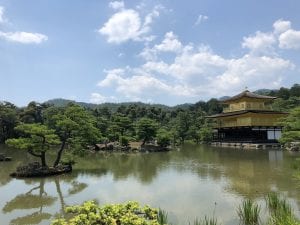
Regardless of what project the student is working on, they embody hard work to the point where group members stay in the office until twilight or the next day. Since the laboratory building has showers and the tea room has a sofa bed, it is entirely possible to live here for a few days. However, the number of hours students put in does not always correspond to an equally fruitful work output. They clock in more hours than there is work to be done, and the hours in the office is not proportional to the products of their time, which is an indication of a productivity problem. This may be the key difference between the work ethic of the Americans and Japanese. While Americans spend less time in the office or sometimes do not even appear in the office, the work is always ongoing whether it is working from home or on the go. The Japanese only work when physically in the office and according to the graduate students I have asked, the home is exclusively for relaxing and rest rather than work and many students leave their computers and work material in the lab even on weekends. In the U.S. it is increasingly common for employees to work remotely as employers encourage employees to work at home. While this may sound like an ideal situation, working from home is by contrast the most demanding work environment in today’s industry. When working from home, employees have no boundaries between work and rest as they begin to mesh, and employers begin to expect them to become a twenty-four work machine where it is impossible to ever “finish” work, explaining why the Americans statistically work longer hours than the Japanese. While both styles of work are undoubtedly unhealthy, the Japanese style of work, although seemingly rigorous on the surface, is actually healthier than what has become of the American employee with their well-defined physical boundaries between work and rest.
The visible work ethic was on full display when one Friday evening, I was asked by one of the postdocs if I would be coming on Monday, which was a national holiday. Arikawa-sensei had let me know that he would not be coming to work on Monday, probably to ease some pressure, but had commented that some students would be performing experiments despite the campus being closed. It was at this moment that I learned some of the senior graduate students come into the lab every day, including weekends. One member of the lab does not even have a shower or gas connection to his home, so he most literally lives in the office, taking showers upstairs and working as late as humanly possible. Another morning when there were intense downpours from a typhoon, I thought I was the first one in the office after Tanaka-sensei since I had to unlock the group offices until I noticed a student passed out on the sofa in the tea room. Even in severe weather conditions when the university had actually cancelled its classes, a student was somehow still in the lab. I know there is no expectation from the professors for the students to work in this manner, but many do this perhaps because it is a group culture of self-enforcing this style of nearly always being present. This is one of the most evident cases of paying extraordinary effort to achieve harmony, a core Japanese value, even when the return on investment is less than ideal. In the U.S., especially in astronomy, there is little to no value placed on time physically in office, working on data analysis or related research tasks, because Americans and many other “Western” societies value the result rather than the effort. While investing energy and effort are certainly crucial, the product is what reaps the rewards rather than the effort and this is an important distinction between the Japanese and American work ethic. However, this may not apply across all fields. For instance, the students of the Department of Astronomy here with whom I have spoken with have said that their research work hours are not defined by time but by the results they deliver to the community. Thus, the work ethic seen in my lab may also be partially attributed to the nature of experimental physics research, which by nature requires more physical interaction and presence with the group in person.
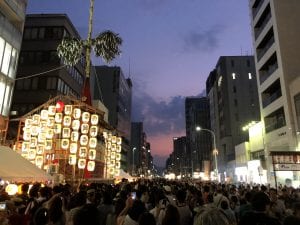
Working in a foreign lab, I believe while there are cultural differences in lab behavior that exists, what may carry the most weight is the lead professor and the research activities of the group. This makes each lab unique and thus, cannot be generalized as “Japanese” or “American” labs and must be evaluated on a case-by-case basis. Many American lab groups also have a similar time intensive work ethic mirroring that of my lab here, and in my own physics department I have noticed incidents where the professor has a student working at what must be unethical hours. I do appreciate the Japanese tendency towards group unity, which creates a variety of team spirit that pushes the group forward in their research goals. Oftentimes, this is the drawback of many American groups as each student is working individually and quite independently making the group less than cohesive. In Japan, nearly any lab group I have observed behave as a team and this is the spirit that allows them to enthusiastically dedicate hours on end in the office. I personally appreciate the daily group lunches and dinners, as these are valuable times to build more personal relationships apart from being professionally associated. Because lab members frequently work independently from one another in the U.S., it is difficult to have these types of group interactions and form this “team” mindset. Although the open freedom in a U.S. lab can be relieving after having spent significant time in a Japanese lab, it would not be easy to find a U.S. lab with a similar level of interconnectedness as my lab here in Japan.
Research Project Update
The first half the week was quite slow as most of the students were attending Excon in Nara, but this meant that I was able to use the lab equipment without scheduling restriction. However, since François was experimenting with his THz microscope and retuned it for his purposes, I was not able to use that until later in the week. To make this wait time productive, since I was missing some samples, I created a large sample of bulk MoS2 deposited on LiNbO3 crystal and while working in the chemistry lab, I noticed I had serendipitously fabricated a moderately sized WSe2 monolayer. After François had finished his work, he showed me the modifications he made to the setup and I worked with that for the entirety of the next day. This time, Arikawa-sensei had brought out a tiny silicon lens that I could try to elicit a response from the terahertz light. However, as I was running the experiment it became apparent that this was not an ideal solution because whenever the silicon lens is placed on the sample and calibrated, the position of the substrate slightly shifts with respect to the stage due to the inherent vibration of aligning the lens. Thus, many measurements were taken on the substrate itself rather than the intended sample. When I finally secured the sample to the terahertz beam spot, the result was less than satisfying as well, as the images were dominated by noise, fringes, or camera artifacts.
I subsequently worked with François in an attempt to rectify this issue since he had the comprehensive expertise in tuning and optimizing the microscope. We went with several different strategies, both through the experimental apparatus and in the analysis. Filtering was added with changing magnification, different conducting bulk samples were tested at high and low fields, and imaging data was transformed into Fourier space. While these methods all yielded noisy data, we were able to better understand why these materials are difficult to observe under terahertz light in the current setup. The problem is with the actual data collection and how the terahertz radiation is entering the material. Previously, graphene had been used as a sample by François and although in principle graphene should have some excitation response perceptible in this microscope, it also was very difficult or simply not possible to determine its response due to the noise. Between this year and last year, the microscope unfortunately has become noisier and this is an ongoing issue that François is addressing during his time here. There was an AND logic gate that was to be placed by the chopper but was somehow removed which may contribute to the increasing of noise. In any case, we will continue to work on the microscope as obtaining a verifiable response would accomplish our primary initial goal of analyzing TMDs with terahertz light at near field.
After discussing the situation with Arikawa-sensei, he suggested that we move forward with the pump-probe setup for the terahertz microscope. Although the setup is not in existence for the terahertz system yet, François will be able to assist in laying out the optical modifications needed in the current configuration and the setup and optimization should take about a day.
Week 10: Reflections on Japanese Language Learning
As with many of the Nakatani Fellows past and present, working in the lab does not demand fluency in Japanese because at a major research university such as Kyoto, students are trained to contribute to the international scientific community where English is the communication standard. I have never needed to use Japanese in the lab for anything related to research. Because the Tanaka Lab always has at least one international member or visitor at any given time, many of the lab’s activities adopt English as the standard as well, including in group meetings, journal clubs, and weekly seminars.
However, Japanese is nearly always used for regular conversation and I have gained significant listening comprehension ability. I am generally very comfortable with foreign language acquisition by listening and at any moment I can comprehend about one-third of what is being said. I am familiar with most of the grammar structures used; the one barrier in developing full listening comprehension is expanding the vocabulary in my Japanese lexicon. While I may more or less have an inherent advantage with considerable experience learning languages and taking advantage of how Japanese shares many cognates with Taiwanese, the vocabulary portion is certainly an area that I should further study. I have also continued to build my kanji vocabulary by learning the correct readings of the characters. Although I can recognize many kanji characters and derive their meanings with ease, I do so from my substantial experience traveling in Taiwan where traditional characters are used. Here, I have taken moments to try pronouncing what is written on signs instead of just reading it for its meaning. Being able to read a sign completely without only understanding its meaning is a highly rewarding experience that has served as an efficient method of memorizing the various readings of identical characters in their correct contexts.
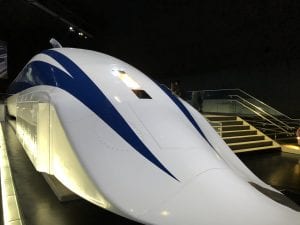
The most challenging language-related experience I have had in Japan was self-induced. When filling out some paperwork to receive my access card to the KU Library, I assumed that all the staff would be comfortable with English as all signs had an English version. However, I quickly discovered this was not the case when I asked in Japanese if English was okay and the response was that they could not understand English, for which I then proceeded to continue in English. What followed was a sequence of handwaving and translating the staff’s visibly pained attempts at English into Japanese, so I could be sure what they were saying. Obviously in hindsight, if I was translating their attempt at English back into Japanese, I had more than the sufficient vocabulary knowledge needed to convey what I needed to communicate, but still chose to use English. This was a time-consuming and counterproductive means of communication that I can count as one of the most interesting linguistic experiences I have had here. However, this experience also presented me with an interesting issue that I uniquely experience amongst this year’s students because if I had started with Japanese, everyone seems to assume that I am Japanese or at least I speak the language natively. On more than one occasion when going to eat with labmates, I have been questioned why I do not speak Japanese because I “clearly look” Japanese, although I am not sure this is an accurate observation…(?) While perhaps I could presumably attract less attention by using Japanese, there is a finite point in conversation when I am unable to respond or continue without using English. Reaching this point makes for uncomfortable moments and through my peculiar interaction with the staff members in the library, I realized that this was another variety of sociocultural quandary which I should approach linguistically.
Despite having taken language classes, much of the language used on a colloquial basis is not formalized in textbooks. Working amongst students has offered me the unique opportunity to fill in my gaps in knowledge and learn the useful phrases and expressions that are more natural than those given in the text. For instance, I have been working on identifying the appropriate verb forms used when interacting with different people. Among lab members, a combination of informal and standard form is used depending on the individual, but the standard forms are always used for the three professors. By keeping my ears open and listening carefully, it has become much easier to distinguish between the different levels of formality in Japanese and gain a sense of where someone’s standing is within a group. The most effective way to learn languages is experiential and I believe the most critical step in starting to learn a language from a completely separate linguistic family is listening comprehension, the most accurate indicator of how firmly a language has been acquired. The ability to learn a language well is significantly hindered by the inability to understand it aurally. Thus, from experience I believe the best technique for starting to grasp Japanese is not necessarily reading a text or reciting kanji although these may be a helpful supplement, but to keep listening and trying to understand what is being said at that moment. Reading and writing are passive learning techniques for languages, whereas the active nature of speaking and listening will train retention. Given the opportunity to be immersed in Japan, it is important to make every effort to use Japanese and interact with people rather than giving up at the outset and using English. A typical issue for foreigners with no language learning background is that they do not even try to use the foreign language and rely on their English resources for everything. Even if your lab speaks English fluently and there is no apparent need to use Japanese, it is not a good practice to give in because you will not learn anything culturally if you stay in your foreign bubble. Although my lab is fully capable of English conversation, I subscribe to conversations to test my understanding of what is happening and respond accordingly.
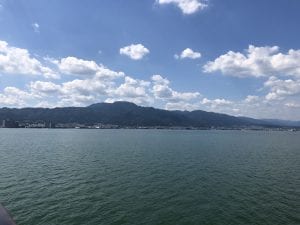
Although my would-be next level Japanese instructor was recruiting me to enroll in upper intermediate Japanese, unfortunately I have no intention to continue formally studying Japanese. However, I would have completed a major in Japanese had I had no interest in science, and I would be far more advanced in Japanese had I made these classes a focus of my undergraduate curriculum. Because almost all language classes are designed with the rigor of a foreign language major at my school, it would be unfeasible to go forward with Japanese and physics as these classes by definition of their major designation conflict in the core schedule. Other than my personal interests in language learning, when I began taking Japanese language classes, my purpose was to gain a fundamental grounding in the culture and language to be better prepared to interact with Japanese researchers who contribute immensely to global scientific projects. By working in a Japanese lab, I hope to become more accessible on a cultural basis for these large-scale collaborations. While I will not be taking further language classes, I hope to connect more with the numerous undergraduate Japanese exchange students that enter our university annually since I now have experience in the role of the international student.
Research Project Update
I worked closely with François this week to troubleshoot our microscope issues and try several strategies to see some confirmable evidence of terahertz response. Earlier in the week, François installed a filter in the probe pulse for noise reduction and resolution enhancement and I went through many analysis techniques to increase the SNR. With each modification to the microscope, I took at least ten measurement runs of the same sample and averaged the images to obtain a CCD error-free combined image sequence. I converted the time-domain images to frequency-domain and normalized amplitude and phase. Even with these methods, we were not able to see the TMDs, and we are suspecting that the instrument may not be able to detect the response above the noise levels. We also attempted depositing bulk WSe2 on SrTiO3 (STO) crystal substrate, which François had used for his own experiments and had yielded positive results for its low transmission, but this proved not to yield reliable results either. When analyzing the depth of the images, we saw there was also some apparent jitter with the terahertz signal that makes it challenging to maintain time-domain consistency in the image measurements across repeated runs.
We have been discussing the possibility of using a pump-probe setup in the terahertz microscope, but this has not been assembled yet. Using a pump will not guarantee an observable response from the TMD and involves risky instrumentation modifications that which would require nontrivial optimization. The simplest method is to build the pump above the sample from the direction of the terahertz pulse, but this would make it nearly impossible to use the optical microscope to find the target sample. In its history, there has only been one instance when a pump was ever built into the terahertz microscope and this was when the sample was sufficiently large enough to not require any particular aiming. However, TMD samples tend to be small on the order of a few tens of microns at maximum, making the focus of the terahertz pulse a crucial consideration in optimization. The alternative is to build the pump from underneath the sample, but the physical requirements of the setup demands that a probe pulse lenses be shifted back because there is no space. Using the laser function of the microscope was also brought up as an option but because the timing is critical and the laser is not optimized for this purpose, a delay line must be used and this laser would not be ideal as a pump. We made the decision to go ahead and build the pump and assess the situation from there because this seemed to be the most promising means to excite the TMD sufficiently for the terahertz response to be detectable.
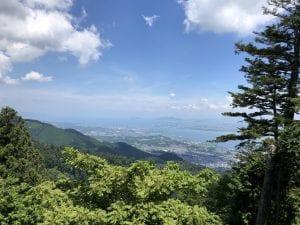
After discussing these issues with Arikawa-sensei, I brought up a problem I felt should be addressed that I thought of when drafting the abstract. Having tried several ways to elicit a response for TMDs from the terahertz microscope, we are under the impression that the conductivity of the material is under the threshold detectable for the microscope, since the gold used for calibration is always visible in the imaging. However, we also have no information on the expected conductivity of the TMD samples in question and thus, it is challenging to derive a quantitative conclusion on whether it is the overwhelming noise of the terahertz microscope that obscures the TMD response or the insufficient doping levels of the TMDs that cause the terahertz waves to pass with no apparent response. In short, I would like to attribute our current imaging process problem as an instrument optimization or limitation issue, as this will inform a more systematic solution rather than trial and error because up to now I believe we have gone through at least five techniques of attempting to enhance the sample’s response through combinations of lens, substrate, and filters. Although the group does not have expertise in carrier transport measurement, Kusaba-san and another member have carried out the procedures for making electrode contacts and measuring conductivity once before and Arikawa-sensei proposed that I could try this measurement while he helps assemble the pump. Before the end of the week, I managed to create some large WSe2 bulk samples on SiO3 substrate for the contacts. Hopefully, these measurements can provide a cross-check for the terahertz microscope imaging that would assist in identifying the threshold conductivity required for the response signal to be observable amidst the noise.
Question of the Week
When I was on the bus last week, a large group of obviously American tourists boarded the bus and after boarding, their leader went up to the driver to ask if the bus went to a certain location to which the driver shook his head and the entire group disembarked from the bus. Not surprisingly, these happenings would put the bus behind schedule, but I was more surprised that two young Japanese ladies were clearly making fun of the Americans and laughing at them for quite a while immediately after they had gotten back off the bus. How much of Japanese hospitality and politeness is actually for show and how is honne and tatemae breaking down in the younger generation?
- This is a good example of how your language comprehension is helping you understand and see various aspects of the society and culture that you might otherwise miss.
- Yes, this does happen and in a city like Kyoto where there are *so many* tourists that take up a lot of physical and infrastructure space you can begin to see the strain of just not being able to get to work on time due to tour groups causing buses to be delayed. This can show up in conversations like what you observed. For more on this, see some of the articles under ‘Tourism: Growth and Impact” on our Travel Resources page.
- However, you see this too in the U.S. or Europe in cities like New York, Washington, DC, Barcelona, and Paris where there are very large groups/numbers of tourists; particularly during the high travel season in the summer months. In DC, you’ll sometimes hear people yell “Stand on the right, walk on the left” right in your ear if there is someone they think is a tourist who is standing on the ‘wrong’ side of the escalator. I know the ‘rules’ in DC, but if I’ve just come from Tokyo where the ‘rules’ are the opposite sometimes I stand on the left without thinking. I’m always really annoyed by people who are so rude to yell like this as I think, “My gosh, if they do that to me what must foreign visitors think of Americans?”.
- This may not necessarily be indicative of a break down in the Japanese cultural values of honne or tatemae. Rather, what you observed is an indication of where societies and cultures can start to show strains in terms of what is a social/cultural ideal vs. how people feel and are impacted in their day-to-day lives. However, it can be shocking to hear just how negatively people sometimes speak about tourists/foreigners in Japanese when they don’t think you understand what they are saying. Unfortunately, Americans sometimes do the same thing too when they assume the person they are talking about doesn’t understand English….
Week 11: Interview with Japanese Researcher

Since I have previously discussed the backgrounds of the students and researchers in my lab for this particular area of solid state physics, I thought it would be especially insightful to expand from this experience and compare it to another department. Drawing from my network once again, a JSPS postdoctoral researcher of astrophysics at Columbia University who is an incoming FRIS Assistant Professor at Tohoku University and had graduated from Kyoto University introduced me to a few researchers in the Department of Astronomy. Since he knows my work well, he pointed me to researchers here who have similar interests. I have met with a doctoral student in the department and a JSPS fellow. The doctoral student is in his second year, Atsushi Tanimoto. The researcher, Dr. Kyuseok Oh, is on a JSPS International Research Fellowship and works with Prof. Yoshihiro Ueda in the Department of Astronomy. I met with them for a couple of hours to discuss my past experience in research, share my findings, current work at UMass, and the possibility for them to give a colloquium in my home department.
Interview with a Japanese Researcher
Dr. Kyuseok Oh received his undergraduate, masters, and doctoral degrees in astronomy from Yonsei University in South Korea. Subsequently, he held a postdoctoral position at the Institute for Astronomy at ETH Zurich for three years before coming to Kyoto University. After completing his fellowship here, he plans to take a research position at an institute for astronomical study such as NAOJ or Kavli IPMU and if possible, would prefer a research-focused rather than a teaching post. He entered the field of astronomy with research focused on active galactic nuclei (AGN) because of the exotic nature of black holes. These compact objects are one of the most popular icons of physics and is what “attracts” many to study astrophysics and undertake studies in physics to understand these mysterious phenomena. Having experienced research in three countries, Kyuseok had many insights into the differing cultures and work ethic of scientists around the world. For instance, Korea and Japan share a more similar working style than Switzerland, which can be contrasted as the “West.” During his time in ETH, the work ethic was much more flexible and liberal, where schedules are more self-defined. In Japan and Korea, there is more of a group focus, although in astronomy since the bulk of work is completed on a computer, the unity of the group is not as tied in as experimental physics groups, for instance. This work ethic is similar to that which I have experienced in the U.S. where there is much freedom in how you distribute your time within the frame of a day, month, or year. Personal responsibility is key to productivity in the U.S. and perhaps even more so in Europe than it is in Asia.
There are many international researchers that work with the members of the Kyoto astronomy group, which I expected because the astronomical world is a tightly-knit community. This was especially the case because I work on a similar research area as both Kyuseok and Tanimoto-san. Depending on the particular project, the location of the international collaboration differs but no matter the field, because carrying out astronomical observations requires astronomically high cost instrumentation, institutional collaborations are vital for any research to be possible. Thus, international experience is imperative and has been important in shaping Kyuseok’s research career moving across different countries. However, Kyuseok also shared the flip side of international research, and that is the time and financial resources needed to foster these connections. For instance, attending the AAS meeting this year made it impossible for him to attend another conference in Chile financially. Even retaining collaboration between cities in Japan was difficult and he cautioned that working remotely especially if the researcher is time zones away can prove to be challenging in the long term. As a result, he emphasized the importance of selecting a research group that matches interests and work style.
As I have heard from many professors and graduate students, the best advice he personally gave me is to choose your doctoral advisor very carefully as it is crucial for you to be able to work cohesively with an advisor to ensure a smoother path towards completing the doctoral thesis. He also asked about my background and we had the opportunity to catch up on research developments in AGN studies, which is particularly interesting since I had worked in the mid-infrared regime and he is currently working on emission lines in the optical range. We also identified several researchers whom we mutually know or collaborate with, including a professor at the Kavli Institute at the University of Tokyo who I had discussed working with this summer and a few in my department who have highly cited publications. Despite the global reach and the network of international collaboration, working in similar areas allows us to connect to each other fairly easily and demonstrates the rewarding fruits of international experience.
The opportunity to sit down and speak to another astrophysicist as an astronomy and physics major from the U.S. doing condensed matter physics at Kyoto University was a truly unique experience that yielded many interesting perspectives on the nature of international research and how this impacts research and career trajectories. By virtue of speaking with a researcher such as Kyuseok, I was further inspired to continue seeking international research experiences and using networking as one of many tools to further research and career objectives. I was surprised to learn about how widespread advisor misconduct is in academia when Kyuseok shared the incident behind why ETH Zurich quietly dissolved the Institute of Astronomy, in which he was a researcher, after it was found that two senior members who are highly distinguished researchers were demanding ‘superhuman’ commitment from their students. This included mistreating graduate students for more than a decade with meetings that went well past midnight and a lack of any holidays while the administration ignored complaints from the students because the director of the institute was the spouse of the professor in question. Presently, the division has been reorganized as the Institute for Particle Physics and Astrophysics. This was an appalling example of advisor misconduct that may not be as uncommon as academia would like to admit, where advisors take advantage of students and use them to further personal career ambitions.
Based on these discussions, I hope to learn more about how Japan, known for its intense work ethic, is addressing the issues of working hours and maintaining a healthier work-life balance. I also hope to learn more about strategies in finding doctoral advisors and how to reach an accurate judgment before committing some of the most important years of academic life to full time research, since it is often difficult to foresee the advisor-mentee relationship until it is too late. The relationship between advisor and student is often a delicate one and I hope to take away approaches to handling such interactions across varying cultural and national boundaries through my international training.
Interview with a Japanese Student
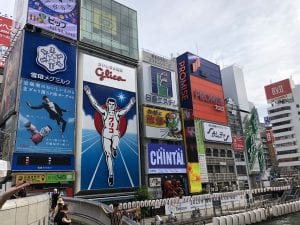
I also spoke to Atsushi Tanimoto, who currently holds a master’s degree from Kyoto University and is working towards his Ph.D. with research in the X-ray region on supermassive black hole characterization, including mass measurements using Chandra, XMM-Newton, and NuSTAR. In completing his degree, Atsushi plans to spend half a year collaborating in Chile before submitting his thesis. As I discussed, because these projects are usually worldwide by nature, traveling to different continents for research is a regular part of even a student’s research obligations in the astrophysics field. Because Atsushi also works on AGN, we share similar motivations for entering the field and pursuing the research career path—sharing the curiosity to understand some of the universe’s most extreme physics at cosmic scales. As a graduate student in Japan, Atsushi mentioned that it is common for students completing masters and doctoral degrees to be recruited by industry for their technical skillsets. After graduating, Atsushi hopes to enter a research postdoctoral position in academia or in a governmental institute. However, he is also open to entering industry should it prove challenging to continue down the research route. Many graduate students including those in my lab eventually join companies because of a higher compensation incentive and it has become increasingly difficult to find careers in academia partly because current professors have continued to retain their positions well beyond the typical retirement age. Astronomy graduates in particular have valuable training in data science and machine learning that they apply to their everyday research tasks, and this level of proficiency is extremely desirable for technology companies.
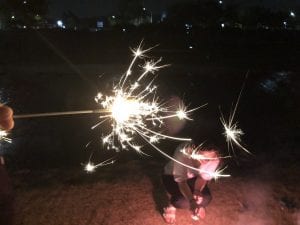
However, being a STEM student in Japan means dedicating the entire undergraduate curriculum to scientific study and thus this makes other critical skills such as communication and writing more challenging to learn as a graduate student especially when faced with working amongst international groups of researchers. Japanese universities do not have the equivalent broad “core” courses that most U.S. universities have in place and consequently, it seems entirely possible for a physical scientist to not have taken a biology class since junior high school, let alone humanities and arts classes. To gain more diverse perspectives beyond science, both Atsushi and Kyuseok harness their experiences abroad and interactions with foreign scientists to fill in these gaps and build networks of resources that the undergraduate experience in Asia is often unable to offer.
Discussing these career possibilities with Atsushi presented some of the unique challenges that Japanese graduate students face when attempting to enter a globally competitive research arena that seems increasingly saturated. One common goal across all the Japanese graduate students in science that I have spoken with is the desire to contribute internationally by attending conferences around the world and working with foreign colleagues. At Kyoto University, these international exchanges are common which I saw myself when I learned that another Japanese postdoctoral fellow with whom I had hoped to connect with was working as a visiting researcher at Academia Sinica in Taipei over the summer. While having international experience is certainly invaluable for our scientific careers as scientists based in the U.S., these experiences are absolutely critical for students in Japan, especially since English is the lingua franca in science and stepping out into the world demonstrates competency on this bottom line. These conversations allowed me to more fully understand how Japan cultivates its researchers, the current challenges, and how internationalization of science has impacted them personally and professionally.
Question of the Week
I am surprised at how many third year Ph.D. students have never published in a scientific journal whereas in the U.S., publishing papers as a graduate student is often a critical step towards a career in research. Given that the students work very hard, have years of research experience at the D3 stage, and do have publishable results, why is this the case?
- Likely because many graduate students, at both the master’s and PhD level in Japan, do intend to pursue careers in industry. If you are applying for a position in industry, research publications may not be as important as if you are planning to pursue a career in academia.
- Also, the structure of PhD programs in the U.S. also often requires a certain number or type of publications or presentations to proceed to the ‘next stage’, though this varies a great day by program/institution. In Japan, this is not as common.
- You may want to talk with your host lab professors about this question to gain some more insight into some of the differences between graduate degrees in the U.S. vs. in Japan.
Week 12-13: Final Week at Research Lab & Re-Entry Program
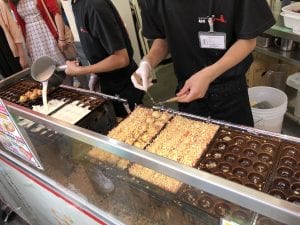
As my time in the lab is coming to a close, I had to complete a series of measurements with my sample for analysis. An important piece of this was finding the thickness of my sample since it was bulk and cannot be characterized with Raman spectroscopy alone. I used atomic force microscopy (AFM) to take these measurements and saw that even in the bulk between splinters in the sample there were some level differences. I then correlated these edges and thickness differences to the terahertz data to analyze the relaxation of the free carriers. Selecting five points for an initial examination, it seemed that the thinner and edge areas of the sample were prone to much more rapid decay than the pristine parts. I was able to discuss these results with Tanaka-sensei who suggested this effect may be a result of defects or the edge state. In an atomically thin sample, it is easy for the lattice to be damaged and inserted with other atoms which would affect the carrier dynamics. The reason behind the dramatically different rates of relaxation for the carriers upon being excited by the terahertz pulse however remains not quite explained, especially since I saw between positions on the sample an approximately ten-time difference between the slowest and fastest decaying parts on the sample.
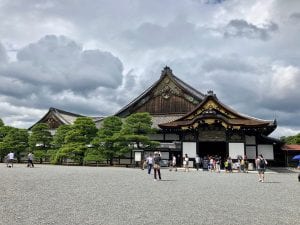
This is an interesting phenomenon, but I do not have the opportunity to explore these effects further in my time remaining in this lab. Because these are the first images ever taken with a near-field optical-pump terahertz-probe microscope of a TMD sample, Tanaka-sensei does not expect there to be enough data to delve into the physics but instead intends to use my experience to lay the groundwork in which near-field terahertz imaging becomes more accessible. This makes our terahertz microscopy method a potentially attractive approach to observe these dynamics of heterostructures and in particular, heterojunctions where migration is an important factor. The contactless yet powerful procedure to observe free carriers in TMDs offers new avenues for engineering more efficient semiconductors in applications such as photovoltaics.
During the weekly journal club, I was able to witness the rehearsal of a lab member’s doctoral defense who had published a paper this year and was eligible to graduate. I would like to emphasize that this was a rehearsal and thus was the first time that everyone else in the lab had seen his presentation and thus, was essentially an open feedback session. I have seen American doctoral defenses, but this was the first time I have seen a doctoral defense in a Japanese university. I was surprised that the defense was both written and presented in Japanese, which seems unusual since upon entering the global scientific community, English is always used unless the graduate matriculates into industry. Despite the technical language, Tanaka-sensei and the other instructors kept voicing suggestions and feedback during the presentation that we spent about half an hour on only four slides on what was supposed to be a 45-minute presentation. Tanaka-sensei would ask probing questions that sometimes doubled as critique and each time this occurred, which was quite frequently, the student would quickly write notes and affirmatively accept these comments without question. Anything contained in the presentation was open to criticism, from the placement and inclusion of figures to the words being spoken. I could sense the scrutiny that the student was facing from the professors as Tanaka-sensei was saying わからない regarding a particular choice of figure on a slide. However, the criticisms were given constructively; Tanaka-sensei often smiled and strongly insinuated suggestions and corrections. There was even one slide in which we spent at least twenty-minutes with discussions amongst multiple members and professors. This exercise was a great opportunity to witness the culmination of many years of work in the lab to obtain a Ph.D. at a Japanese university and the amount of preparation that we need as science undergraduates to reach this level of research maturity.
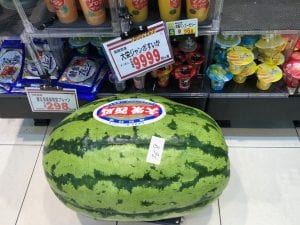
Before leaving Kyoto University, I wanted to explore as many of its facilities as possible and I was fortunately granted a tour of the Nanotechnology Hub (ナノハブ) of the university, which contains four cleanrooms for semiconductor and chemical fabrication and analysis, and a host of sophisticated instrumentation for open campus use. The center was part of the Nanofabrication Platform Consortium which has sixteen member institutions in Japan, including AIST and NIMS. I was able to go inside a Class 100 and 1000 cleanroom with numerous equipment for etching and photolithography. Kusaba-san arranged for a Nanohub engineer to take me to the different component lab centers around campus where I saw the sophisticated capabilities of their university facilities that demonstrated a firm commitment to world-leading research especially with microelectronics. Almost all the machines were Japan-made with the occasional Zeiss optical instrument. Many of the areas I toured required advance permission to enter and I am grateful to the Nanohub staff and Kusaba-san for allowing me access to see the sheer breadth of research in action here at Kyoto University. On my last weekend, Mari and I met one more time as she took me to places on campus that I did not get a chance to see, including the South Yoshida area. We had the chance to discuss the research training in Japan and undergraduate life at the university, and I was able to answer any final questions Mari had before traveling to Houston a week after us.
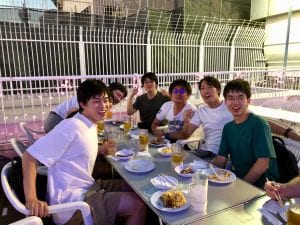
The lab held a lavish farewell party evening for me and François during our last week that most certainly sealed our connections. We had a rooftop “beer garden” dinner in the Kawaramachi area and after eating our fill until closing time, we went to an izakaya to continue the night. It was during this time that I found out the group had turned 101 years old this year and has an illustrious history at Kyoto, having been visited by Albert Einstein himself in 1922. I will always remember the privilege to working in the kind and warm atmosphere my lab gave me while I worked there and before departing, I distributed my cards of appreciation and farewell omiyage before having my final dinner with labmates on the Friday night prior to leaving Kyoto. I plan to keep in touch with my lab, especially the members who I became closer with over the many meals we had together even if I do not necessarily plan to stay in the same field of research.
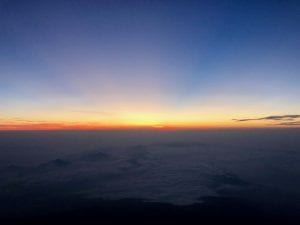
On the final weekend, I climbed to the summit of Mount Fuji with about half of this year’s group to witness the sunrise. After acquiring the necessary gear, including a headlamp, gloves, and an extra jacket, I joined the others in Shinjuku and we headed to the Fifth Station to commence our nightlong climb. We began hiking before 9 pm and within the first hour, our group had already somewhat disintegrated. Kaitlin, Janmesh, and I led in the front and with our pace, we likely were a full half hour ahead of the rest of the group. We stopped for a break only once so we could purchase hot beverages from one of the mountain huts along the trail and we reached the ninth station slightly after 1 am. We climbed too quickly and we waited around the rocky slopes at the ninth station since the sunrise was around 5 am. Because the ninth station has no mountain hut, it was very cold with the wind chill and unfortunately for my fellow climbers who had not brought the appropriate attire, this break of inactivity for them did not help in the subfreezing temperatures. We huddled tightly for these hours and tried to stay awake, since falling asleep would reduce core body temperature. After a demanding two hours, we finally decided to set off to complete the final leg to the summit in time for the sunrise. At this point, the trail had become so crowded that moving up the slope was much like lining up. However, seeing the breathtaking sunrise at 4:56 am made the night climb and coldness well worth it when glowing red rays emanating from the emerging sun washed over our numbed faces over the bed of clouds beneath us. With all mountain peaks lower than us, we could see their peaks slightly above the cloud tops and the scene was reminiscent of traditional Japanese paintings that illustrated the mountains literally floating in distance over a sheet of white and new sunlight. Being on the highest place in Japan was truly a culminating and fitting conclusion to the months that we spent in the land of the rising sun.
Final Presentation at Closing Ceremony, University of Tokyo
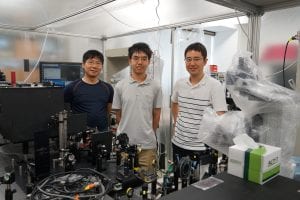
Presenting my research and life experience in Japan to the Nakatani Foundation was a suitable conclusion that summarized my stay here. Preparing the presentation was a refreshing exercise in organizing my thoughts and highlighting what I believed was most important in and beyond the lab. I was also interested in hearing from the other fellows’ research results and appreciating the assortment of cutting-edge research being conducted across Japanese universities. Seeing the other fellows compare and contrast the Japanese and American lab experience also revealed the multifaceted perspectives that we each adapted to thrive in a largely foreign environment. Most importantly, these differences indicate that each lab is unique and cannot be necessarily categorized as “Japanese” or “American” which I believe was a major takeaway from these presentations. For this presentation, I shortened my introduction and gave slightly more detail to describing the terahertz microscope I used since the instrument itself was an important highlight of my project given its scientific uniqueness. However, the more time I spent on discussing my research, the less I was able to dedicate to my qualitative experience in the lab. Nevertheless, I enjoyed these presentations thoroughly and the opportunity to reflect on my time in Japan with the fellows after a packed three months of traveling, making mistakes, and ultimately succeeding.
Re-Entry Program at Rice University
Research in Japan had always seemed a distant goal but having experienced life in a Japanese laboratory for an extended period, Japan has become much closer. Many of my expectations working in Japan were met, including the highly organized and meticulous approach to work and life. Being amongst the Japanese graduate students working in a new field in a new country for me was eye-opening professionally and personally even with the international experience I have had in the past. I became more proactive and resourceful in the lab, and became more independent. When I first started my involvement in research, I was always instructed procedurally, step by step. However, the freedom I experienced in my lab here in Japan encouraged me to think ahead to the next steps and formulate my own analysis when things did not go as expected. Having the privilege of taking the keys to use nearly whichever instrument or lab bench I needed made me take ownership of my work and capability to produce meaningful results. Thus, I have become more able to function independently as a productive research student and progress towards becoming a researcher.
Rather than defining values by country, this experience has taught me to place culture in context and adapt to the situation. Instead of seeing differences, I experienced the common bonds that unite us together both scientifically and personally. While I saw firsthand the signature Japanese work ethic, in learning about their working style I learned that Americans surprisingly put in more hours than their Japanese counterparts. This led to a discussion with my labmates about perceptions of life and work. In Japanese companies, employees work when physically in the office whereas in the U.S., it is increasingly common for employers to encourage telecommuting. The Japanese have a very well-defined set of core hours while the standard nine to five in the U.S. has eroded, giving way to a twenty-four hour work machine. However, the camaraderie among my Japanese labmates was tangible and will be one of the aspects I will most fondly remember about working in Japan. The group meals and the conversations we would have outside of science made the lab a place to grow not merely professional relationships, but supportive friendships as these students spend years together. Despite my short-term visit as a temporary member, I left with deeper connections with my labmates than I could typically expect working the same amount of time in an American group.
This first experience in a predominantly hands-on experimental physics research lab further underscored that “research” is a lengthy process that is filled more with voids and dead ends than results. Particularly palpable in the experimental portion was the amount of time and even physical effort needed to produce verifiable and meaningful analysis, especially when the vast majority of lab time would be allotted to calibrating and troubleshooting tools and electronics. The patience and detail-oriented nature of the work only served to reinforce my motivation to pursue a research-related career in physics. While I am not yet certain which subdiscipline of physics is most suitable for me, the process of inquiry and error in research continues to appeal to my interests in using the language of science and mathematics to describe nature. Expertise in optics and photonics is relevant to projects pertaining to the development of astronomical tools and exploring spectroscopy on a microscale has initiated my interest to take another look at this field. I also experienced the importance of skillset adaptability when I was able to put my computational experience to use in image analysis and although I was somewhat skeptical of my qualifications to dive into experimental condensed matter physics, curiosity and a willingness to learn are the only true prerequisites of research no matter the subject.
During the Re-Entry program, we had the opportunity hear from graduate students and faculty members about research in academia and professional development. I found the session with Prof. Kevin Kelly on the path to graduate school especially valuable as the time for applying draws closer. Although I have always had the general idea of the path I should take, Prof. Kelly laid out the steps clearly and did not hesitate to mention the challenges of the graduate school undertaking. We were further taken to the realities of being a graduate student with the student panelists who emphasized as work and life begin to meld together and the importance to seek a supportive advisor. I also enjoyed hearing from Dean Matsuda about his personal experience and rather roundabout career path to become an academic. I have heard a number of these anecdotes before but none as convincing as his. There is no real “traditional” way to the professoriate and instead of aiming for a moonshot position, the takeaway is to take one step at a time and be led by what life presents you with.
When speaking to a family member, I would say I learned most how to seek resources and navigate foreign places successfully. When speaking to a professor, I would highlight how I was able to grow as a researcher by adapting my computational skills in separate area of physics to a completely new field of research and growing new transferable skills from this learning experience. To a potential employer, I would emphasize my newfound experience working internationally in a non-English native country to collaborate and contribute on a global scale. For a student, I would stress the importance of building an international network and the ability to be immersed in another culture as a means to broaden the educational foundation beyond the technical skills taught in the classroom. While the research work I carried out most certainly extended and deepened my scientific expertise, experiential learning on a day-to-day basis was a reality of life abroad that builds character.
Final Research Project Overview & Poster Presentation
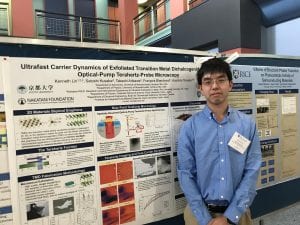
I enjoyed the opportunity to present my research progress at the SCI Colloquium because it allowed me to recapitulate all that I had done in the lab in an accessible manner. Despite being a completely new area of physics for me, I found that presenting my work made me more comfortable with the subject and coherently articulating the physics often seemed as if I was teaching myself. I had presented at the poster session of the AAS Winter Meeting earlier this year, one of the largest academic conferences in the world, the SCI Colloquium was at a much smaller scale and was much less overwhelming a setting.
Research Project Abstract & Poster: Ultrafast Carrier Dynamics of Exfoliated Transition Metal Dichalcogenides with Optical-Pump Terahertz-Probe Microscopy (PDF)
Recipient: SCI Summer Research Colloquium Undergraduate Poster Presentation Award
Host Lab in Japan: Kyoto University – Solid State Spectroscopy Group, Tanaka Laboratory
Host Professor: Prof. Koichiro Tanaka and Prof. Takashi Arikawa
Mentor: Mr. Satoshi Kusaba
Introduction: We sought to characterize the carrier dynamics of transition metal dichalcogenides (TMD) for the first time using the novel, contactless technique of terahertz microscopy. In particular, we used a pump-probe setup to excite the carriers of bulk molybdenum disulfide and observed the relaxation that resulted.
Big Picture: Understanding the free carrier dynamics of TMDs are critical for realizing their potential applications in optoelectronics and energy, including in photovoltaics where we can increase solar cell efficiency by studying their free charge carriers in these new materials. TMDs offer an alternative to silicon as a semiconductor as it combines the benefits of gapless graphene being atomically thin with the unique feature of having an intrinsic bandgap that renders it ideal for transistor applications. Moreover, harnessing the terahertz regime enables non-destructive probing of atomically thin materials, and offers a first look at how using terahertz microscopy enhances our ability to characterize such materials.
Approach: Samples of TMDs, including MoS2 and WSe2 were fabricated in the lab in various layer thicknesses, from monolayer to bulk. These were first characterized using Raman spectroscopy in search of Raman mode peaks and then deposited onto LN crystal substrate. This was also the first time that a thin TMD has been transferred to an LN substrate, used to enhance the terahertz signal. The TMDs were then analyzed with an optically-pumped terahertz microscope, a unique setup that enables spatially-resolved imaging of sample areas larger than a single point. We used atomic force microscopy to cross-check our findings from terahertz imaging.
Results: Our most significant accomplishment was successfully imaging the MoS2 sample in the terahertz for the first time and being able to observe the free carrier dynamics of the sample. Most notably, we observed uneven relaxation of the free carriers in the TMDs despite a sample that appears uniform. We observed that the differing rates of relaxation can be attributed to the varying thickness of the sample as evidenced by atomic force microscopy.
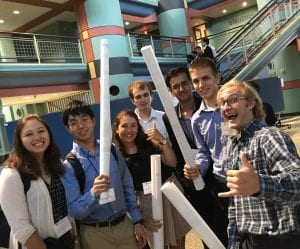
Discussion: Our results most importantly provide a proof-of-concept that terahertz microscope imaging is a powerful new tool for studying carrier dynamics of atomically thin materials, particularly TMDs, analysis that would significantly benefit from contactless probing. We observe that in bulk MoS2, the movement of free carriers are greatly affected by the presence of edges and differing thicknesses of a single sample. With a layer thickness difference of only about 500 nm, the time constant of decay doubles where the sample is thicker. Similarly, the edge state contributes to a substantial acceleration of carrier relaxation rate, which may be a consequence of defects that occur in positions of sample imperfections. Understanding such dynamics are important for the engineering of semiconductor devices that take advantage of MoS2 and similar TMDs’ features including its ability to be as thin as a single layer lattice. MoS2 in particular has a high potential to be commercialized in optoelectronics because of its relative abundance and lower cost.
Next Steps: We intend to further study the effects of the edge state and defects on carrier relaxation in TMDs as we work to improve the microscope for increasingly thinner samples. The laser power was not sufficient in our current experiments to be able to see monolayer TMDs, but this is a pending goal. Moreover, our study of the effects of imperfections and defects in a singular sample motivate renewed interest in examining various heterostructures to observe carrier migration across junctions, which when optimized gives rise to valuable potential in photovoltaics.
Follow-on Project
I am hoping to give a closed-door colloquium of my project to my department, which Arikawa-sensei had encouraged before I left. In this way, my goal is to inform the faculty of what students may be interested in and promote the possibility of international research for undergraduates. I also hope that UMass will be able to establish a relationship with an international partner as strong as Kyoto University and I hope my involvement there and my outreach at UMass will be able to foster this type of international growth on my campus.
I also am thinking of working with the UMass Office of National Scholarship Advisement to promote the Nakatani RIES program and international research in general for our Commonwealth Honors College students, many of whom have great interest and potential in research and study abroad. This may take the form of being on a study abroad style panel or contributing in a scholarship and fellowship information session. Studying abroad for STEM students at UMass is uncommon and presenting this opportunity hopefully will inspire students to seek experiences internationally and improve our own global outreach programs.
Tips for Future Participants
Preparing for Research in Japan
- Find out about your project as early as possible and ask in advance for review papers to get caught up with the lab’s research program and hit the ground running when you arrive.
- Have a look at the equipment the lab has if it is listed on their website, since it may be helpful to become familiar with the techniques most used in their research.
Pre-Departure Tips
- Watch as many episodes of NHK’s Japanology as possible—these give a highly informative and succinct background to various Japanese attractions and aspects of Japanese culture relevant to daily life.
- Connect with Japanese international and exchange students at your home university as they are best qualified to answer questions related to life in Japan.
What Gifts to Bring
- Individually-wrapped boxes of food well-known from where you are from is the best omiyage for the lab group. School-branded products are ideal for the professor or mentor with whom you work.
Mid-Program Meeting Tips
- Network as much as possible with the Japanese Fellows especially if they do not live in your host city. They are our peers and are extremely accessible, a great source of modern cultural knowledge in Japan.
- The Mid-Program presentations are more of a self-assessment of your progress and how well you understand your project rather than a showcase of results, which is not expected.
Working with Research Host Lab
- Ask many questions to your host professor and/or graduate student mentor including about research and life in Japan. Be engaging.
- Try to be proactive with your mentor and professor—sometimes taking a little initiative goes a long way with avoiding lapses of sitting at the office. If you have a research idea or a next step, just ask and go for it.
Living in Research Host City
- Find and shop at the nearest neighborhood supermarket to save money as convenience stores are generally more expensive.
- Obtain commuter transportation passes that will be cheaper to use than swiping an IC card for each ride. For Kyoto City Bus, there are packets of bus tickets sold at Kyoto University co-op stores at a discounted price.
Language Study Tips
- Take a few Japanese classes at your home university, if possible, prior to coming to Japan as it will significantly aid your reading and writing, especially with kanji.
- At the beginner stage, between hiragana and katakana, learning katakana well will be a bigger asset in Japan.
- Try to make out announcements in Japanese at train stations since these are essentially the same on any train in Japan and will come in useful when sightseeing independently.
What to Eat
- Try all the varieties of bento at the supermarket and let your labmates inform your dietary choices.
- Find out what the local specialty is and try everything at least once.
What to Buy in Japan
- Japanese stationary—these are some of the best pencils and pens in the world available at prices you would never see in the U.S.
- At the airport or in Hokkaido, Potato Farm’s snack is definitely a must-buy and make uniquely delicious gifts.
What to Do in Japan
- Go to a local summer festival in the area, especially the Gion Festival in Kyoto. The “main event” procession is actually not where the festival peaks; instead, the yoiyoiyama “street party” a couple days before is where the streets flood with thousands of festivalgoers.
- Weather permitting, climb Mount Fuji! Bring sufficient water for the climb up and down—usually 2L is plenty—since the vending machines at the summit are selling bottles for ¥500.
Places to Visit in Japan
- The area around the summit of Mount Hiei is a close yet refreshing retreat from the Kyoto city center. Taking the cable cars and ropeways are an adventure and the views of Lake Biwa are unmatched.
- The top three train museums are in Nagoya (JR Central), Kyoto (JR West), and Saitama (JR East), and have some of the most comprehensive exhibits I have ever seen in the world.
